A surge of wellness-focused design is putting green back in the spotlight, and nowhere does it work harder than on a single statement wall. From soft sages to saturated emeralds, today’s colour-drenched rooms lean on green to add nature’s calm, disguise everyday scuffs, and support eco-friendly paint choices—all while spotlighting the wall itself as tactile artwork. Textured finishes, biophilic materials, and pattern-rich applications have climbed the 2025 trend lists, proving that a well-planned green accent wall can be both functional and unforgettable.
1. Emerald Board-and-Batten Green Accent Wall Adds Architecture

A crisp grid of board-and-batten painted deep emerald instantly turns a blank expanse into built-in architecture, making small rooms feel custom without expensive millwork. The raised battens cast subtle shadows that highlight the green’s richness, a visual depth trend editors rank among 2025’s top “textured wall” upgrades. Pair the classic colour with brass sconces and pale rugs so the moulding stays the star. For a renter-friendly twist, install thin MDF strips with removable adhesive, then roll on a low-VOC satin finish to catch evening light without a mirror-like glare. Finish by sealing the joints with caulk for a seamless, heritage look that holds up to everyday bumps.
2. Serene Sage Green Accent Wall for a Restful Bedroom
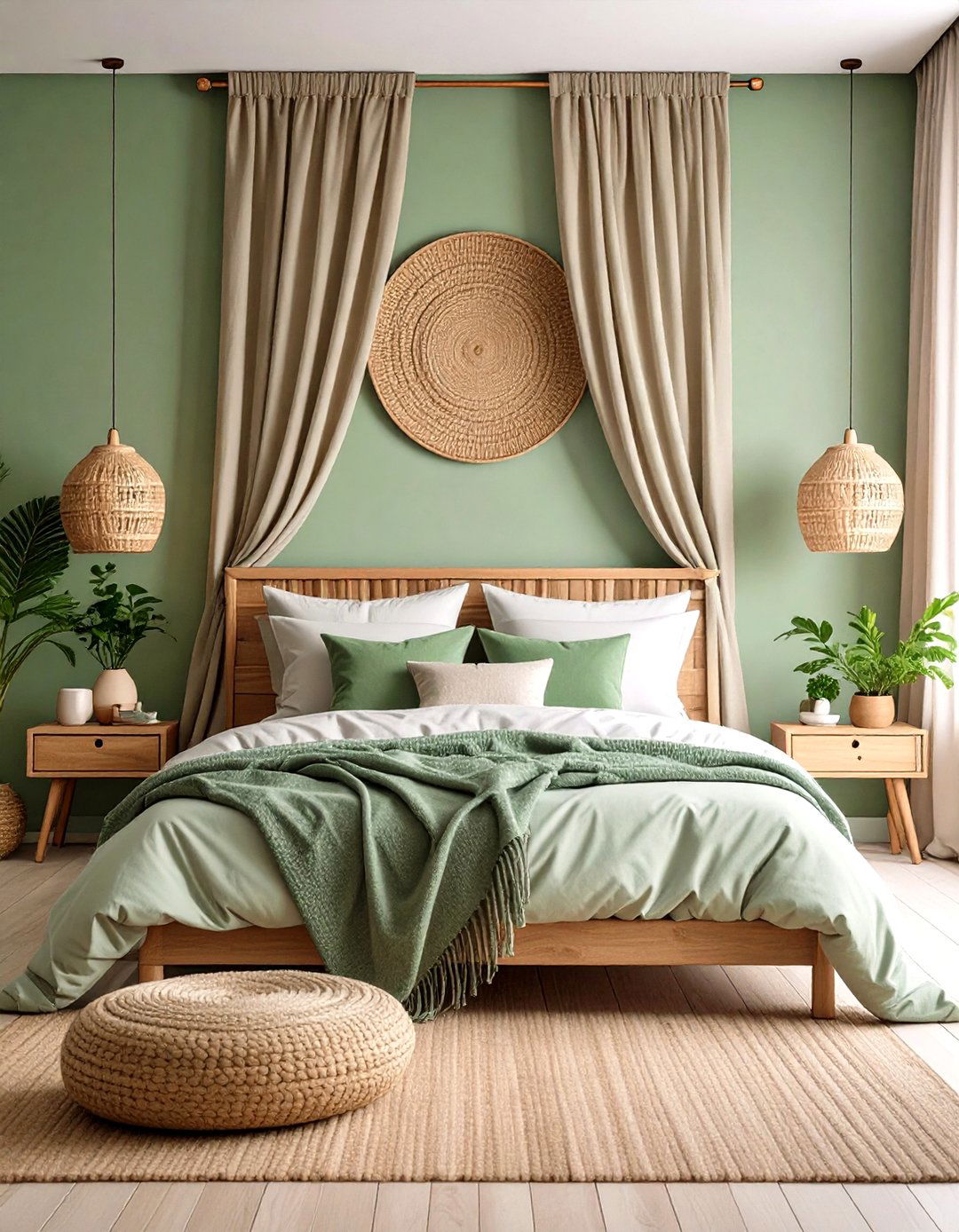
Soft sage settles nerves and lowers visual “noise,” which is why designers favour it behind headboards where the eye first lands each morning. Because this muted tint carries a touch of grey, it behaves like a neutral—easy to refresh with seasonal bedding yet soothing enough to promote sleep. Keep adjoining walls warm white, add linen curtains, and layer woven textures to echo sage’s natural roots. If your room is north-facing, pick a mid-tone formula; a south window can wash light sage out. A matte finish avoids unwanted sheen, ensuring the wall reads as a gentle backdrop rather than a glossy focal point.
3. Forest Green Slat Green Accent Wall for Drama
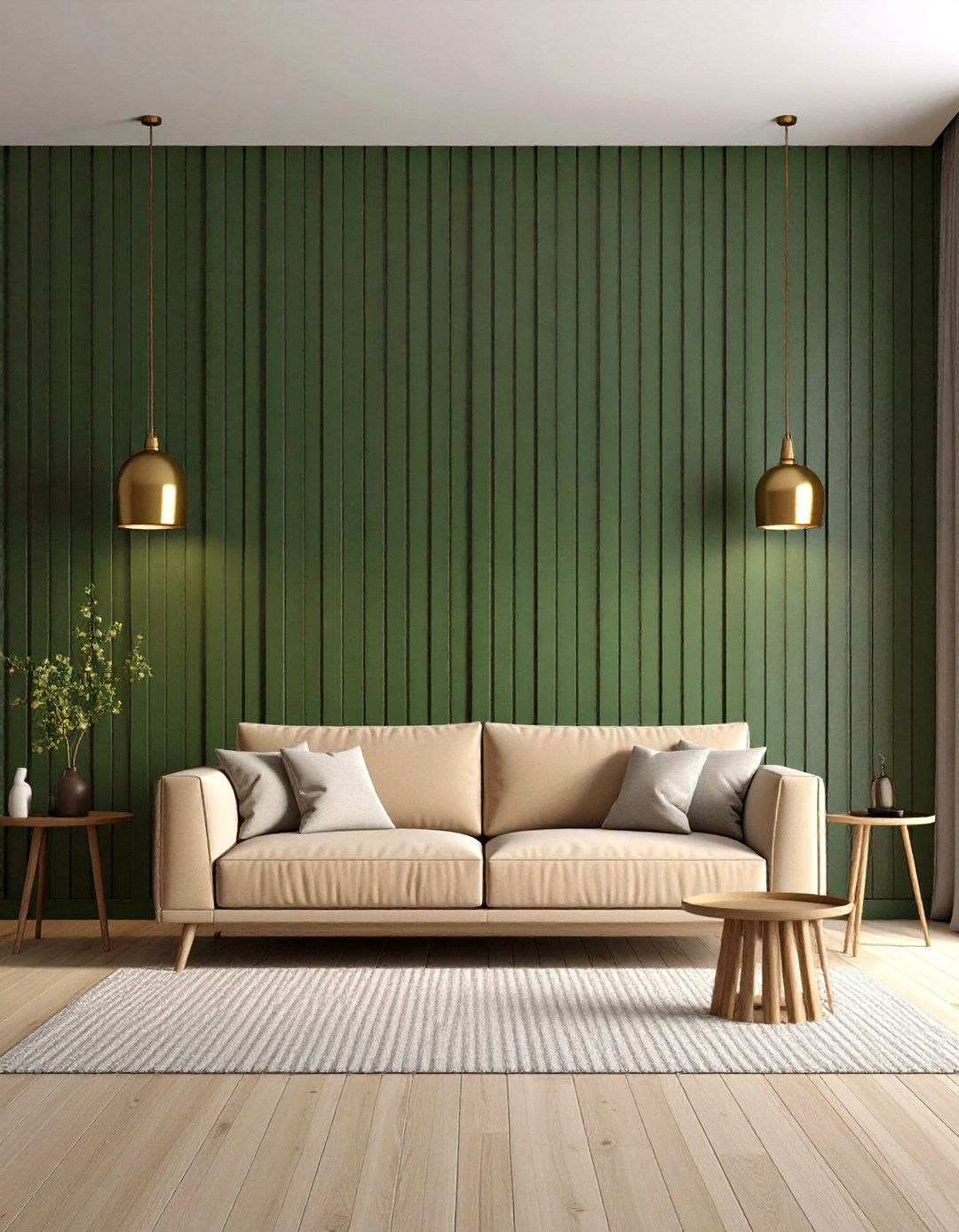
Stretch narrow planks vertically, stain them in moody forest green, and you’ve created a contemporary riff on wood panelling that designers now choose over once-ubiquitous navy. The linear lines draw the eye upward, adding perceived height in low living rooms while the dark hue anchors large furniture. Leave ¼-inch gaps for shadow reveals that enhance depth. For a budget version, paint pre-primed furring strips, glue them in rows, then roll the same green between slats so the wall reads as one sculptural surface. Metallic fittings—think brushed gold wall lamps—pop brilliantly against the deep backdrop without fighting the grain’s subtle texture.
4. Olive Geometric Green Accent Wall for Playful Depth
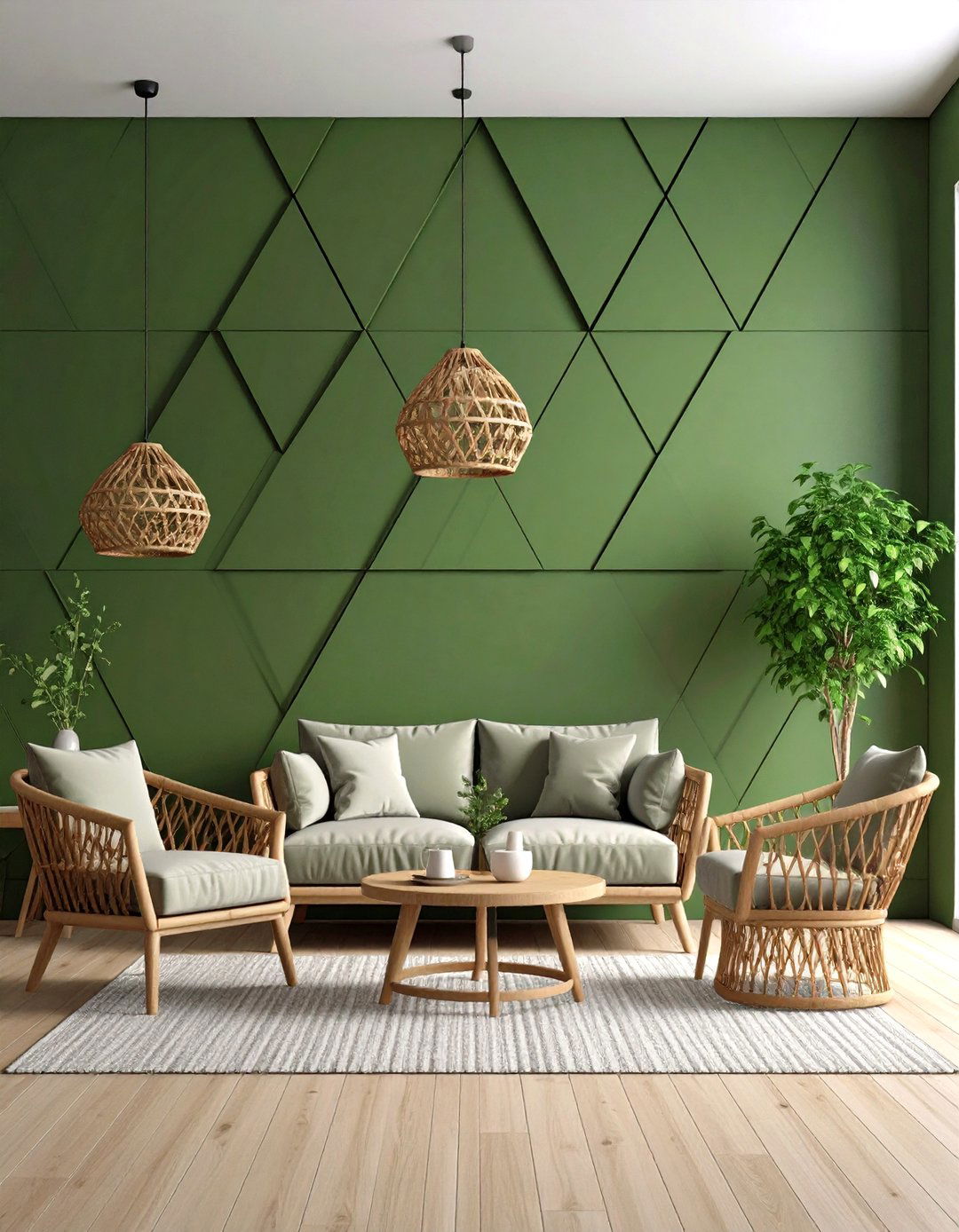
Bold yet earthy olive shines when sliced into chunky triangles, diamonds, or chevrons across an accent wall. Tape the pattern with low-tack painter’s tape, alternating full-strength olive and a 50-percent-tinted version for subtle contrast that looks like shadow play rather than busy patchwork. Because olive contains brown undertones, it pairs effortlessly with camel leather and rattan, making the geometry feel warm, not hard-edged. Keep furnishings simple—a natural-wood desk or mid-century sideboard lets the wall command attention without overwhelming the room’s function. A water-based eggshell finish gives just enough light bounce to outline each shape when sunshine shifts.
5. Botanical-Mural Green Accent Wall Brings Nature Indoors
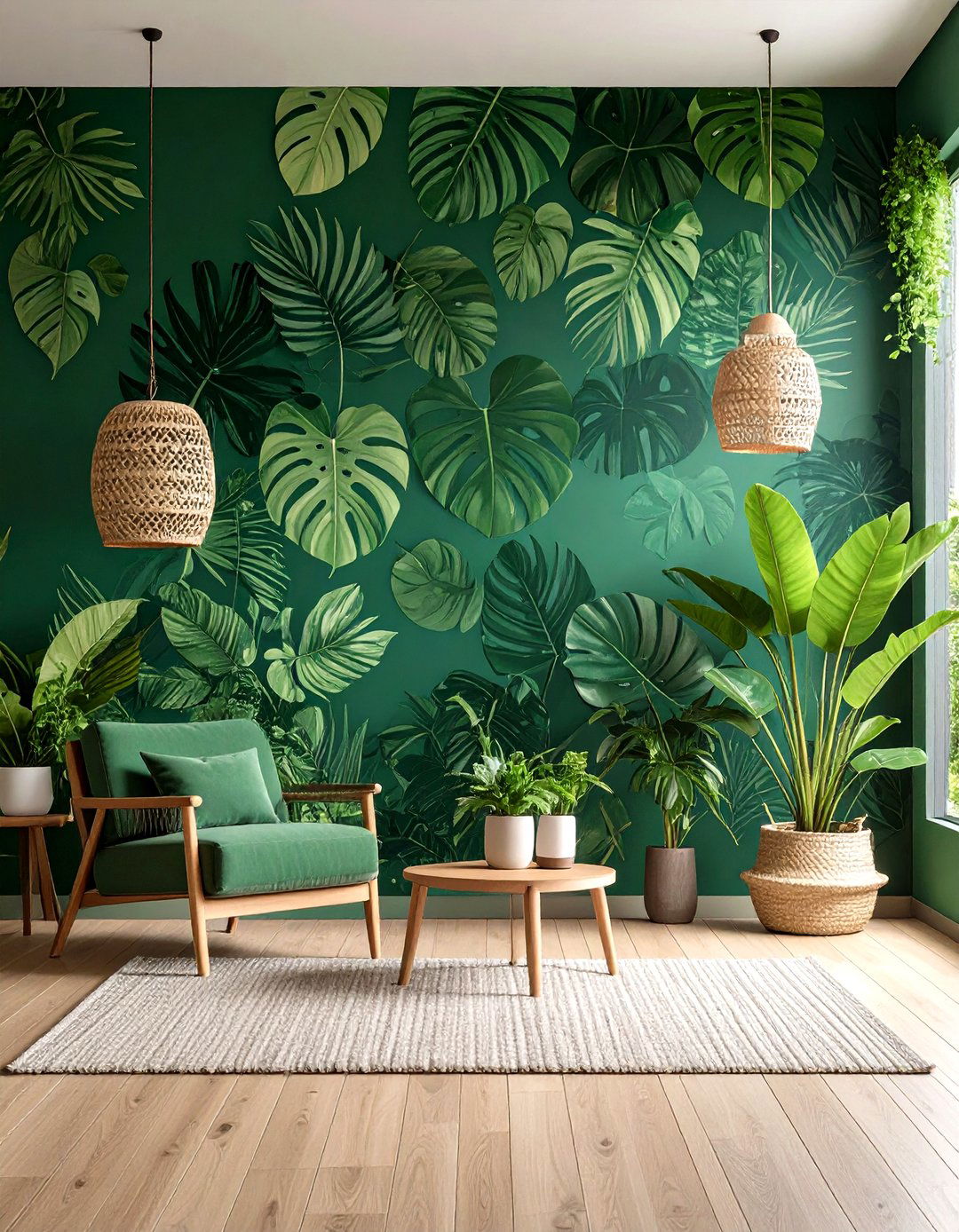
A sprawling leaf mural floods a wall with layered greens, acting as living artwork that needs zero watering. Peel-and-stick panels depicting banana leaves or delicately drawn vines deliver the garden effect overnight, satisfying the ongoing wallpaper-as-art trend. To avoid visual chaos, limit the mural to one surface and pull a background shade for cushions so the palette feels intentional. Matte finish murals cut glare and hide minor wall flaws, while large-scale prints prevent the “busy” vibe small repeats can cause. Add real potted plants in varied heights to deepen the illusion of stepping into a conservatory.
6. Vertical Shiplap Green Accent Wall for Cottage Charm
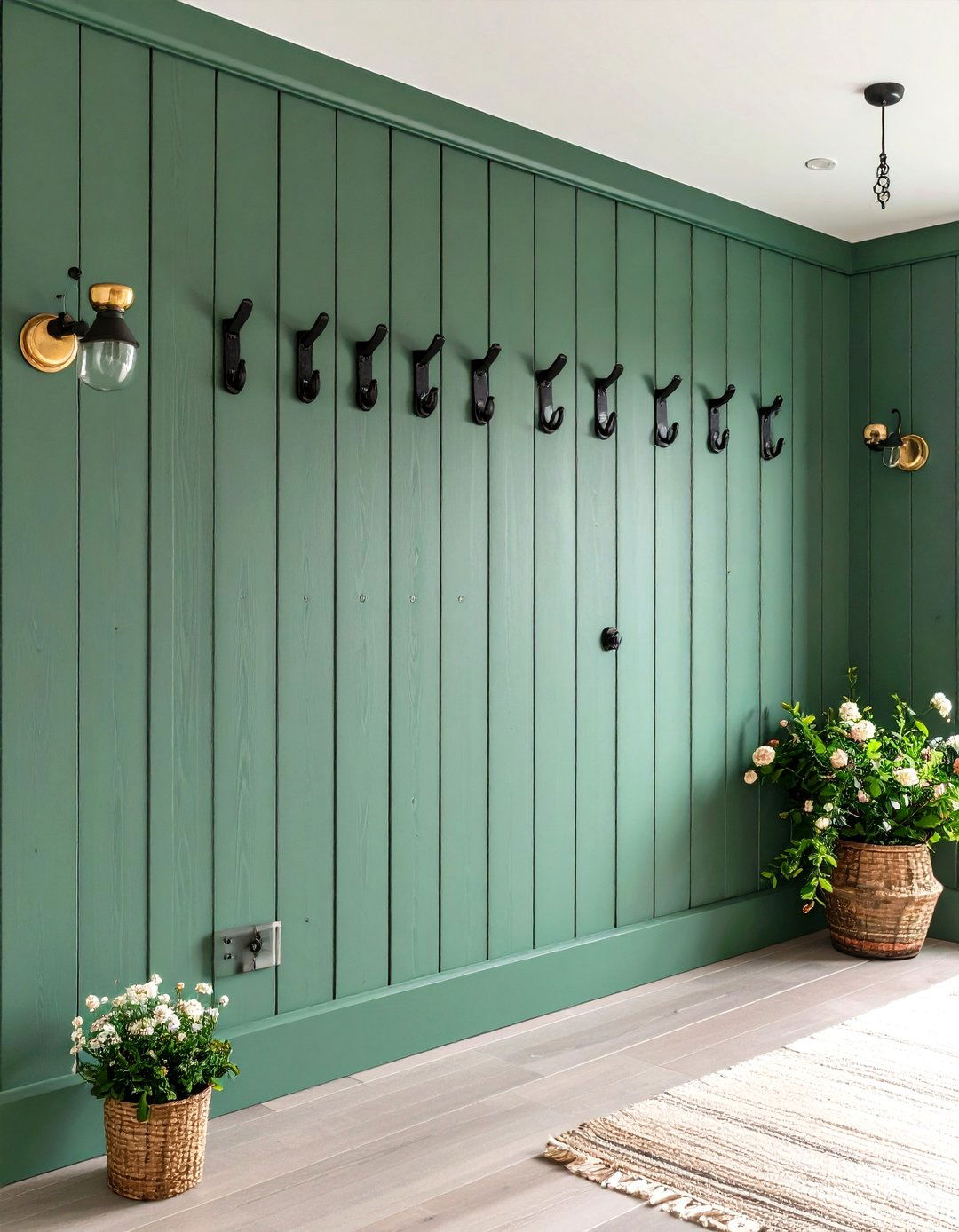
Painted shiplap instantly channels farmhouse freshness, but switching the usual white boards to a mid-green hue modernises the look. Run the planks vertically to elongate walls and keep seams tight to avoid distracting shadows. Semigloss enamel wipes clean—ideal for entryways where backpacks scuff—and bounces enough light to keep the colour lively. Style with black hooks or antique brass pegs so outerwear becomes art against the coloured backdrop. If installing real boards isn’t feasible, use MDF groove panels or paint faux lines with a level, gaining texture without carpentry. Pair with checkered floor tiles for an almost-English cottage nod.
7. Textured Limewash Green Accent Wall for Soft Movement
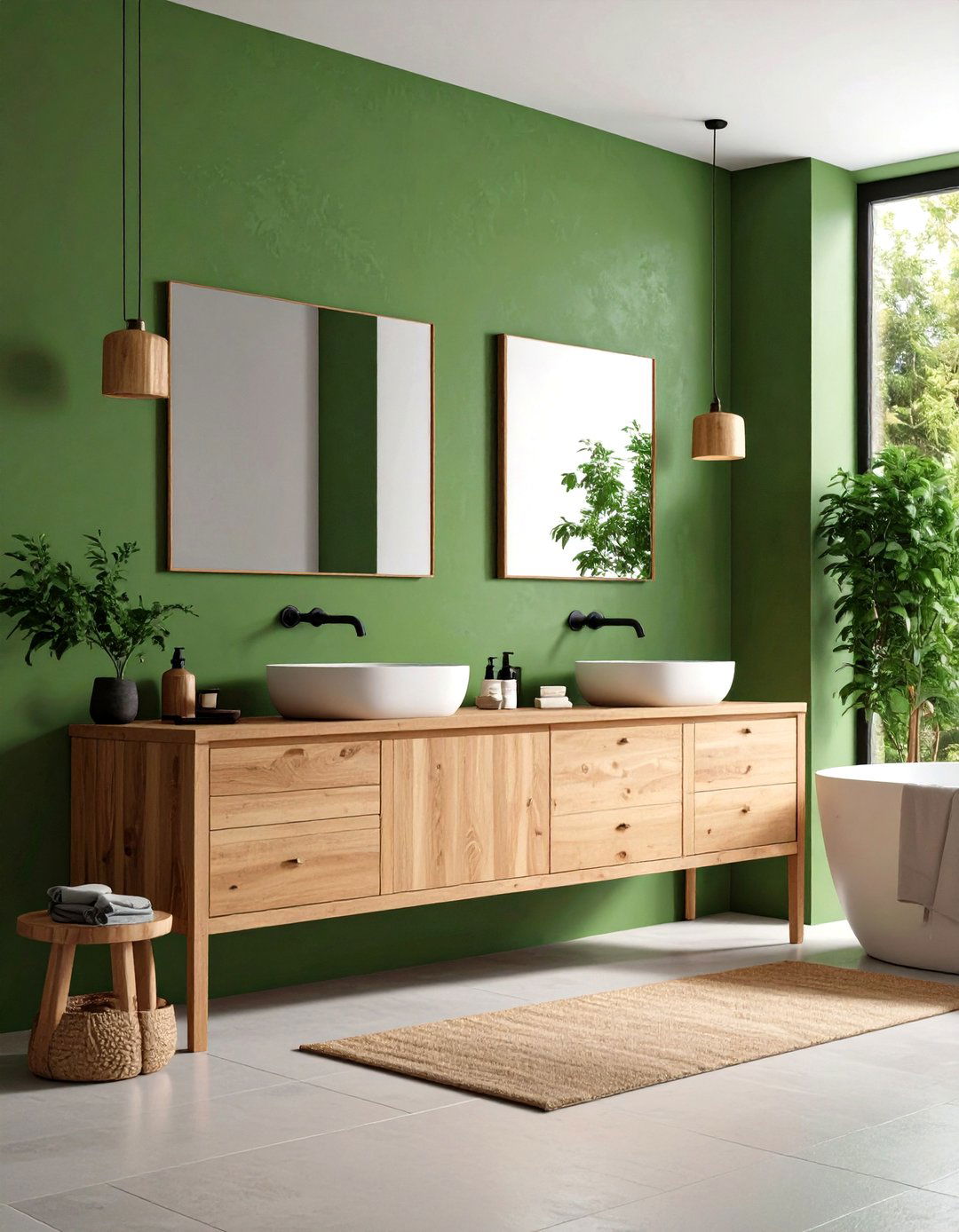
Hand-brushed limewash paints deposit mineral colour with subtle tonal shifts, resembling aged plaster and catching light like velvet. Designers praise its “chalky body” for adding dimension where flat paint falls short. Choose a mid-tone eucalyptus green; strokes dry lighter, so test swatches first. Because limewash is highly breathable, it also regulates humidity—handy in steamy en-suites. Protect adjacent ceilings with wide tape, work in organic X motions, and resist over-brushing once the coat begins drying to preserve the cloud-like texture. Finish the space with raw wood stools and linen blinds that complement limewash’s soft, historical character.
8. Living Moss Green Accent Wall for Biophilic Calm
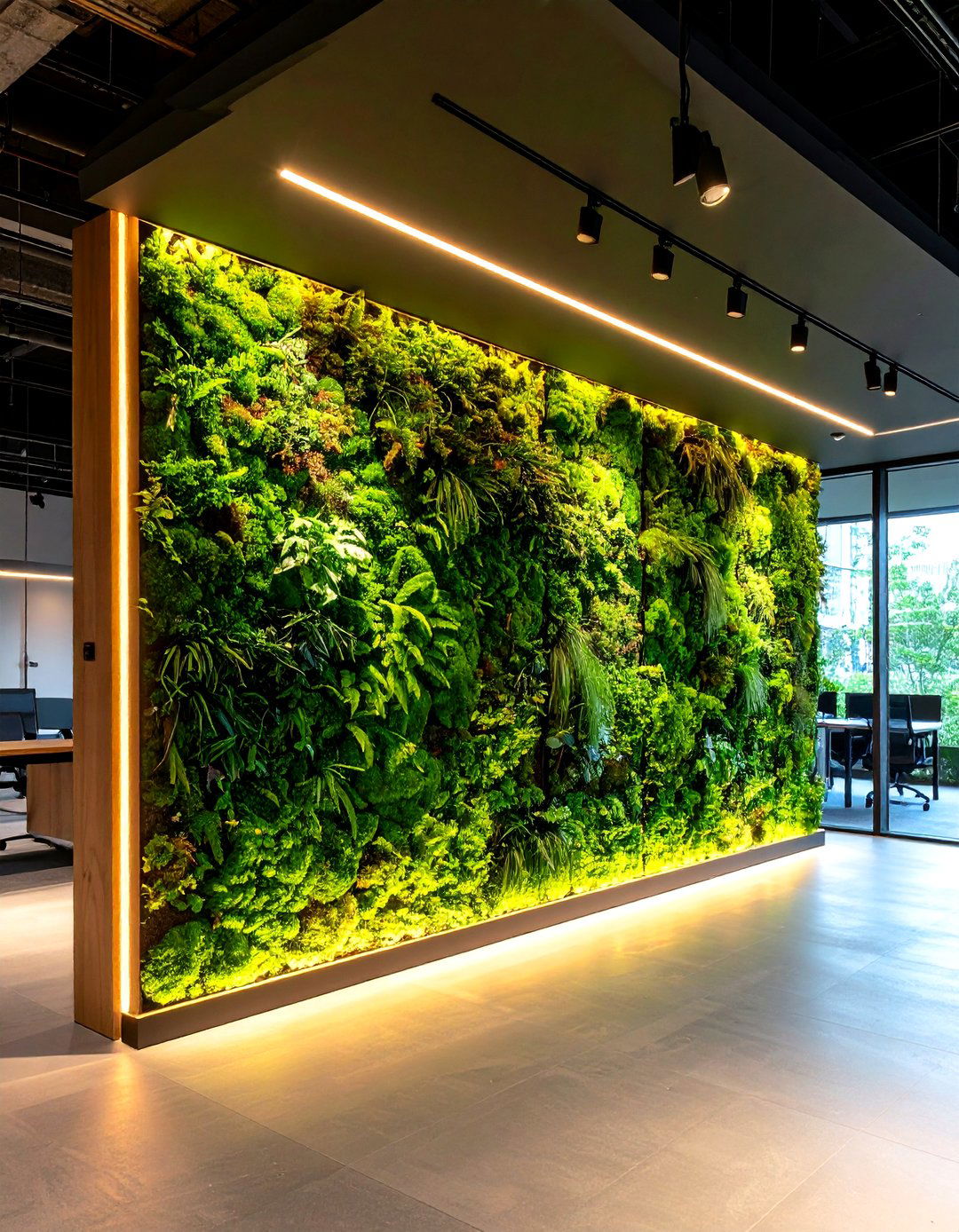
A preserved-moss panel turns an ordinary wall into a vertical garden requiring no sunlight, watering, or soil. Designers install these tactile surfaces in offices to reduce stress and improve acoustics, capitalising on biophilic principles that link greenery with mental restoration. The rich, naturally varied greens read like a thousand micro-accents, eliminating the need for extra art. Moss tiles adhere with construction adhesive; a perimeter reveal keeps edges crisp. Because preserved moss absorbs ambient humidity, keep rooms between 40–60 percent RH so the wall stays plush. Backlight it with hidden LEDs to cast gentle shadows that highlight the organic undulation.
9. Chalkboard Dark Green Accent Wall for Creative Spaces

Swap the classic black slate for hunter green chalkboard paint and you gain an accent wall that invites doodles without dominating sightlines. Kitchen command centres, kids’ study nooks, or brainstorming corners thrive when notes, menus, and sketches sit at eye level on a wipe-able surface. Season the paint with a full-side chalk rub before first use to prevent ghosting. Surround the wall with lighter cabinetry or trim so the functional surface feels intentional, not temporary. Keep a brass rail of chalk and erasers handy—both practical and decorative against the deep canvas.
10. Ombre Green Accent Wall Fades from Light to Deep
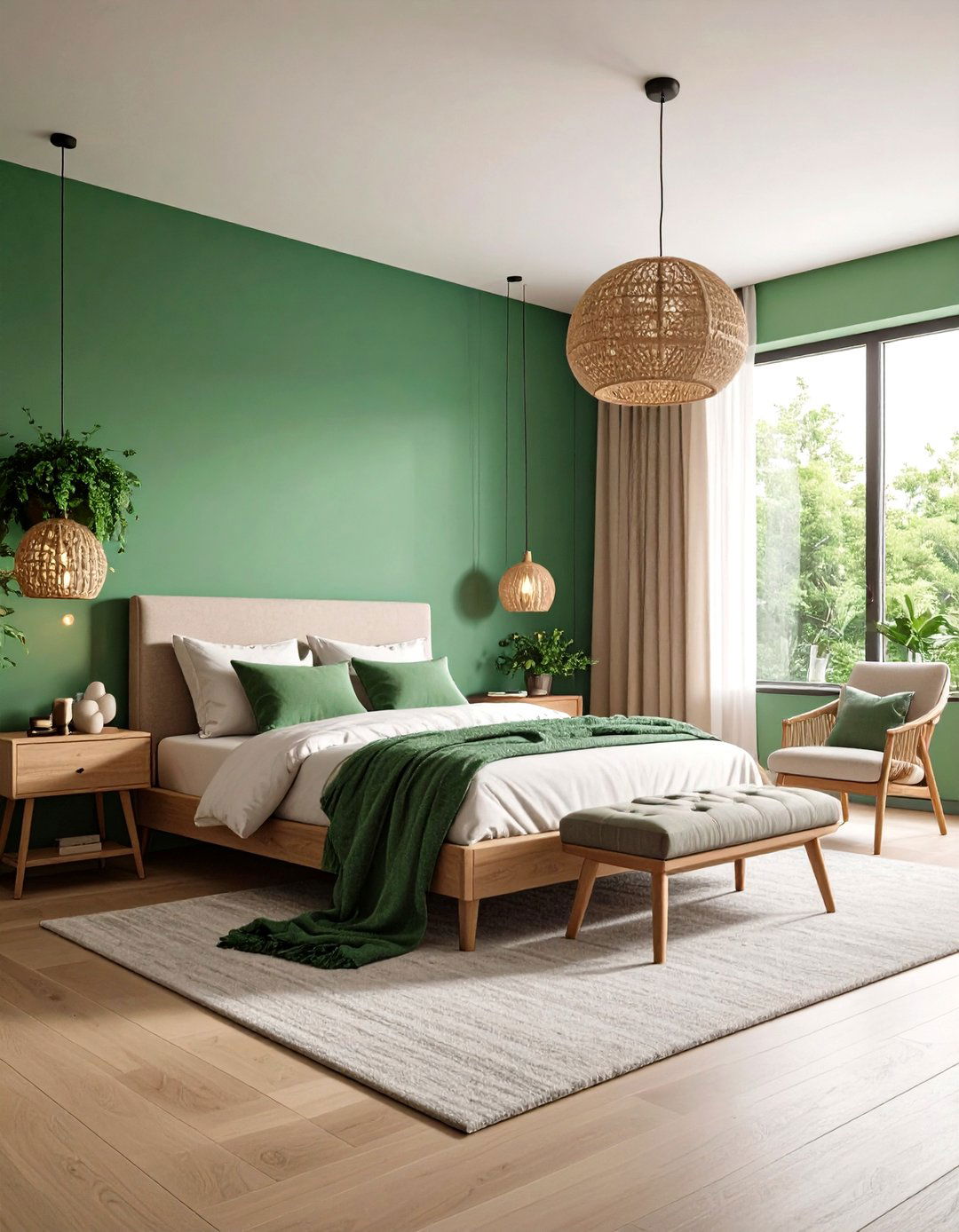
Gradually blending mint at the ceiling into rainforest green near the floor creates a soothing horizon line that makes ceilings look taller and corners softer. Ready-made ombre wallpaper panels ease installation, while DIYers can follow a three-shade sponging method for a custom gradient. Blend each transition while wet to avoid banding; a large, dry brush softens edges. The effect shines behind a bed or dining banquette, where seated eye level meets the calm mid-tone zone. Limit furniture colour to neutrals so the wall remains the room’s gentle, ever-changing artwork.
11. Tropical Leaf Wallpaper Green Accent Wall as Statement Art

Overscale palm fronds or banana leaves printed in saturated emerald offer a dramatic alternative to gallery canvases. Because the repeat reads like one large painting, the wall doubles as both colour source and focal point. Balance the bold pattern with solid upholstery—sand linen or dark cane—and pick one leaf hue for small accessories. Modern paste-the-wall papers let future redecoration happen with minimal damage, perfect for trend-fluid decorators. A matte varnish topcoat adds wipe-ability in high-traffic dining zones without altering colour.
12. Teal-Green Tile Accent Wall for Spa-Style Bathrooms
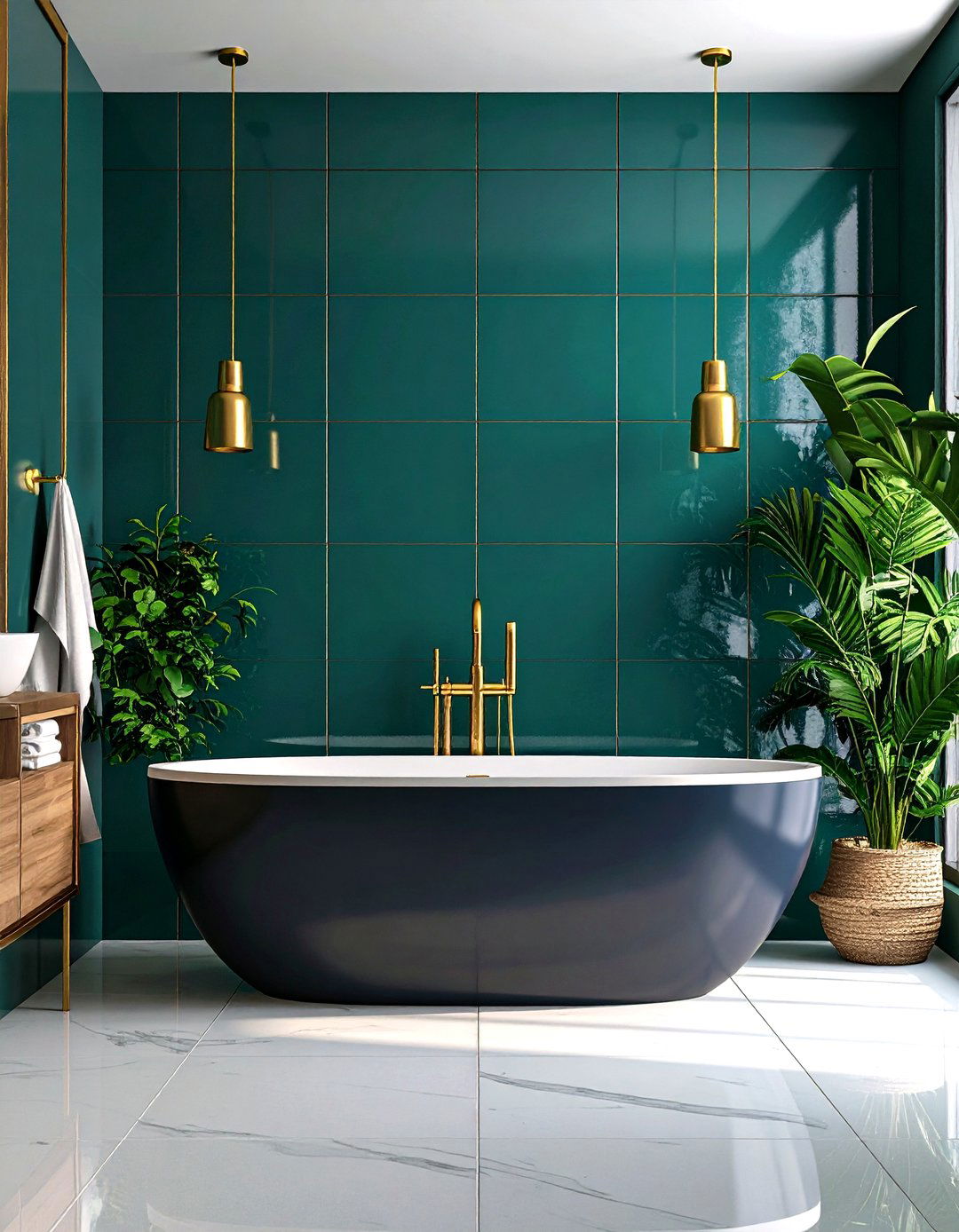
Glossy teal-green tiles laid floor-to-ceiling behind a vanity or soaking tub deliver resort vibes while standing up to moisture. Designers suggest hand-made or subway formats for subtle texture that catches candlelight. Pair with unlacquered brass taps; the metal’s warm patina balances the tile’s cool tone. Grout in a matching green keeps the look seamless, whereas white grout lends vintage contrast. Extend the colour onto the ceiling border for full cocoon effect, then ground with pebble-textured bathmats so the space feels connected to nature’s water element.
13. Velvet-Panel Green Accent Wall Adds Luxe Texture
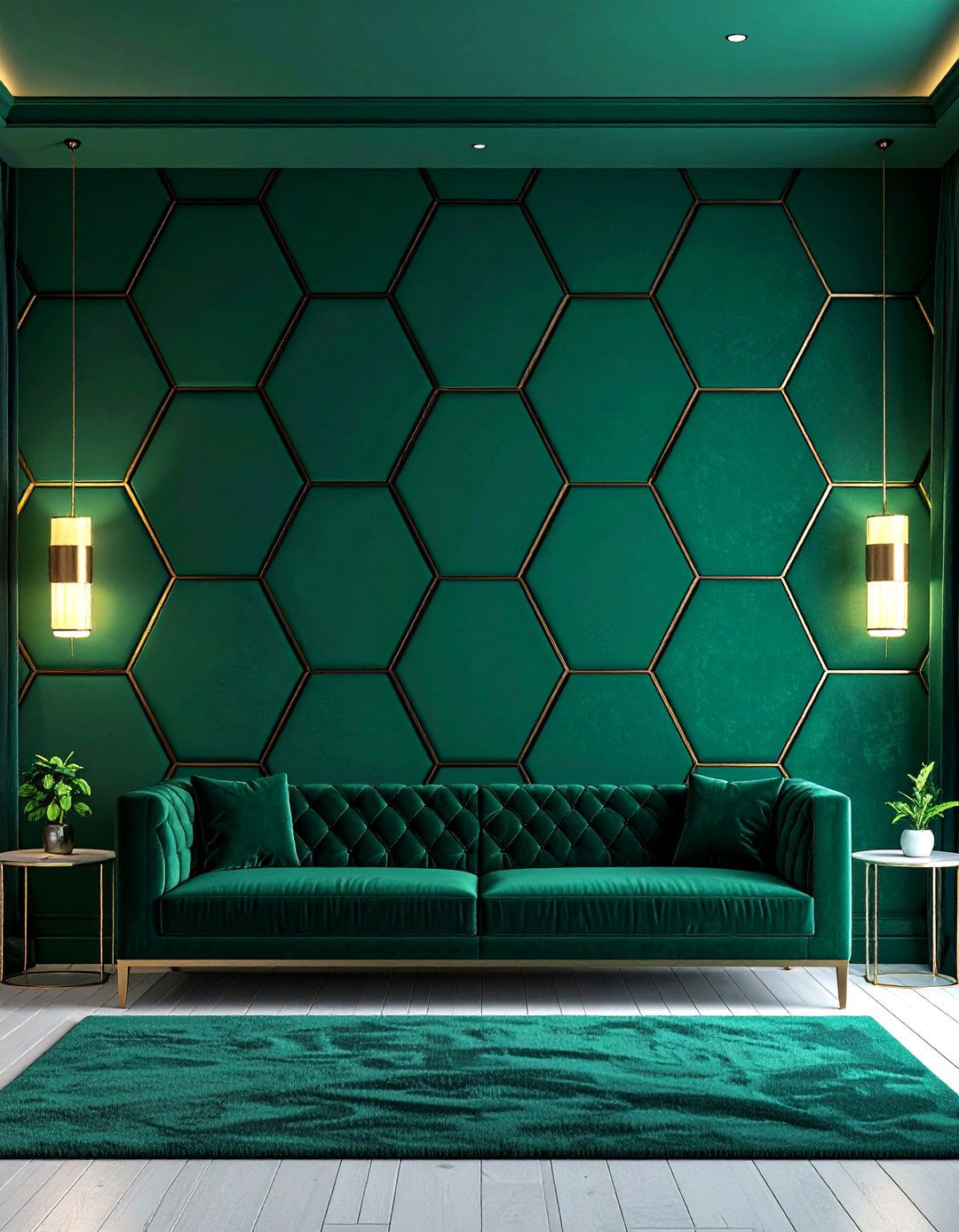
Plush emerald velvet panels mounted like giant hexagons transform sound and style in equal measure, doubling as an acoustic headboard in bedrooms or media rooms. Peel-and-stick options simplify installation; align edges tightly so seams disappear into the pile. The textile’s light absorption deepens colour, creating an enveloping backdrop ideal for movie nights. Flank with dimmable sconces to let the nap shimmer softly. Because velvet can attract dust, lightly vacuum panels monthly with a brush attachment to maintain that showroom sheen.
14. Nursery-Ready Board-and-Batten Sage Green Accent Wall
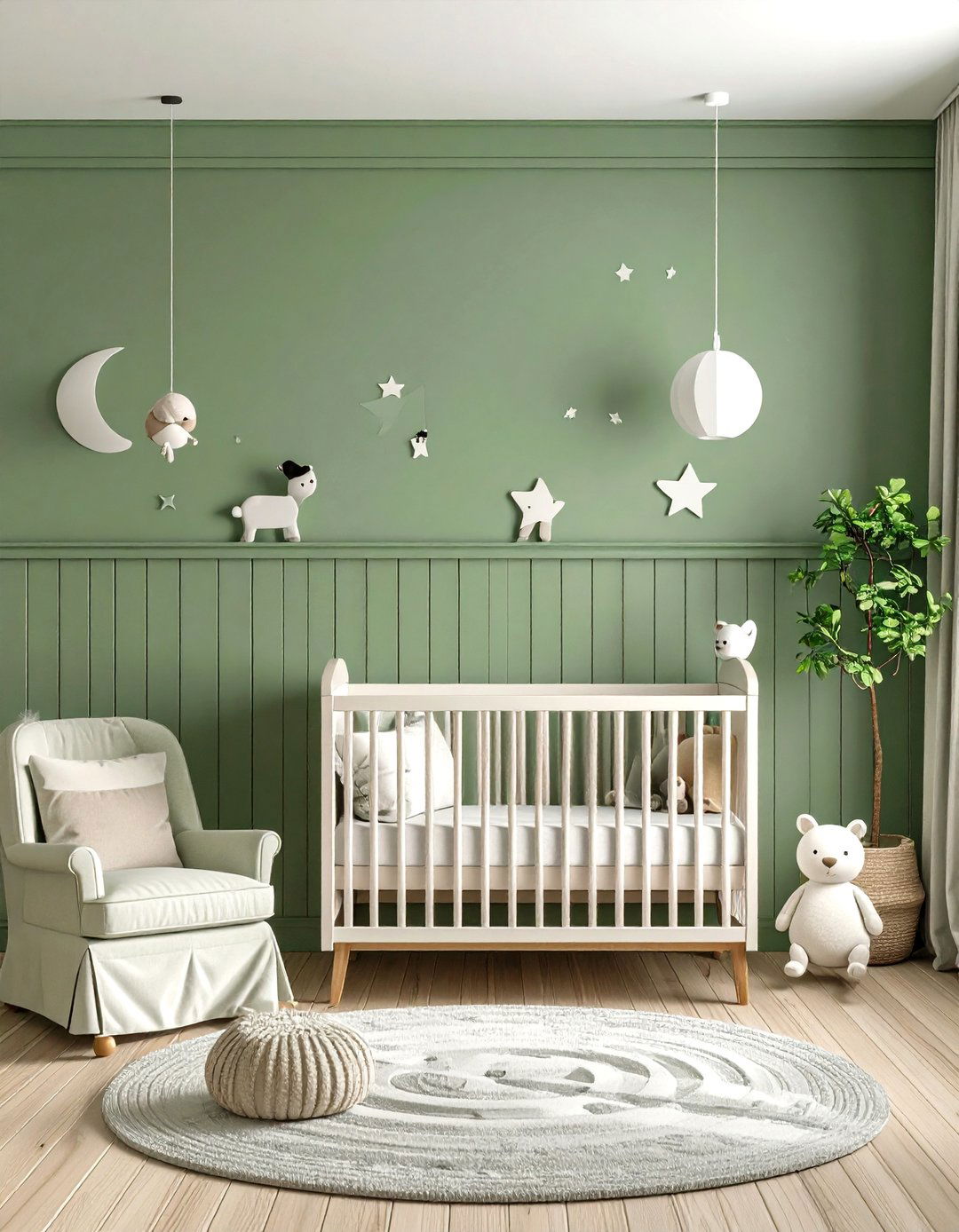
Soft sage paneling adds both visual interest and a gender-neutral palette in nurseries, pairing easily with woodland or floral themes that can evolve with the child. Low-VOC paints ensure indoor-air quality, while rounded battens (instead of sharp-edged moulding) offer safety. Paint only the top two-thirds of the wall green, leaving white skirting below; this keeps cribs and toy storage bright. Add removable animal decals so future updates won’t require repainting every growth spurt. Finish the ceiling in creamy white to bounce soft lamplight during bedtime stories.
15. Mint Green Accent Wall with Crisp White Wainscoting
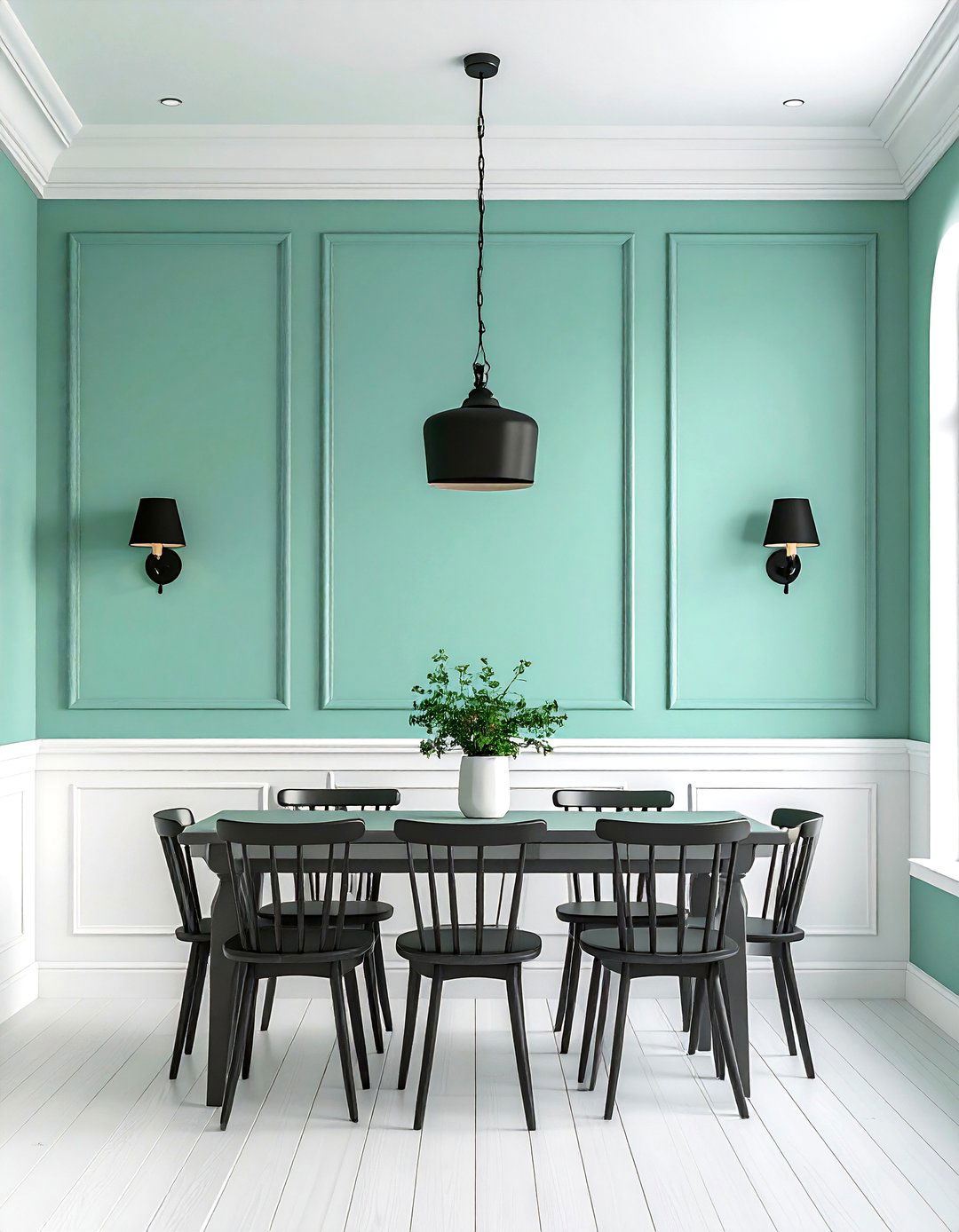
A pastel mint upper wall sitting above classic white wainscot brings fresh air to dining nooks or hallways without overwhelming square footage. The lighter tint expands narrow corridors, a trick colour experts recommend for busy family zones. Paint the chair-rail level wainscoting in durable semigloss for easy scrubbing, then finish the mint in eggshell for subtle contrast. Accentuate with black picture lights and monochrome prints so the palette remains sophisticated rather than sugary. For renters, apply peel-and-stick beadboard panels below and a removable pastel above to mimic millwork minus nail-holes.
16. Terrazzo-Inspired Painted Green Accent Wall for Fun
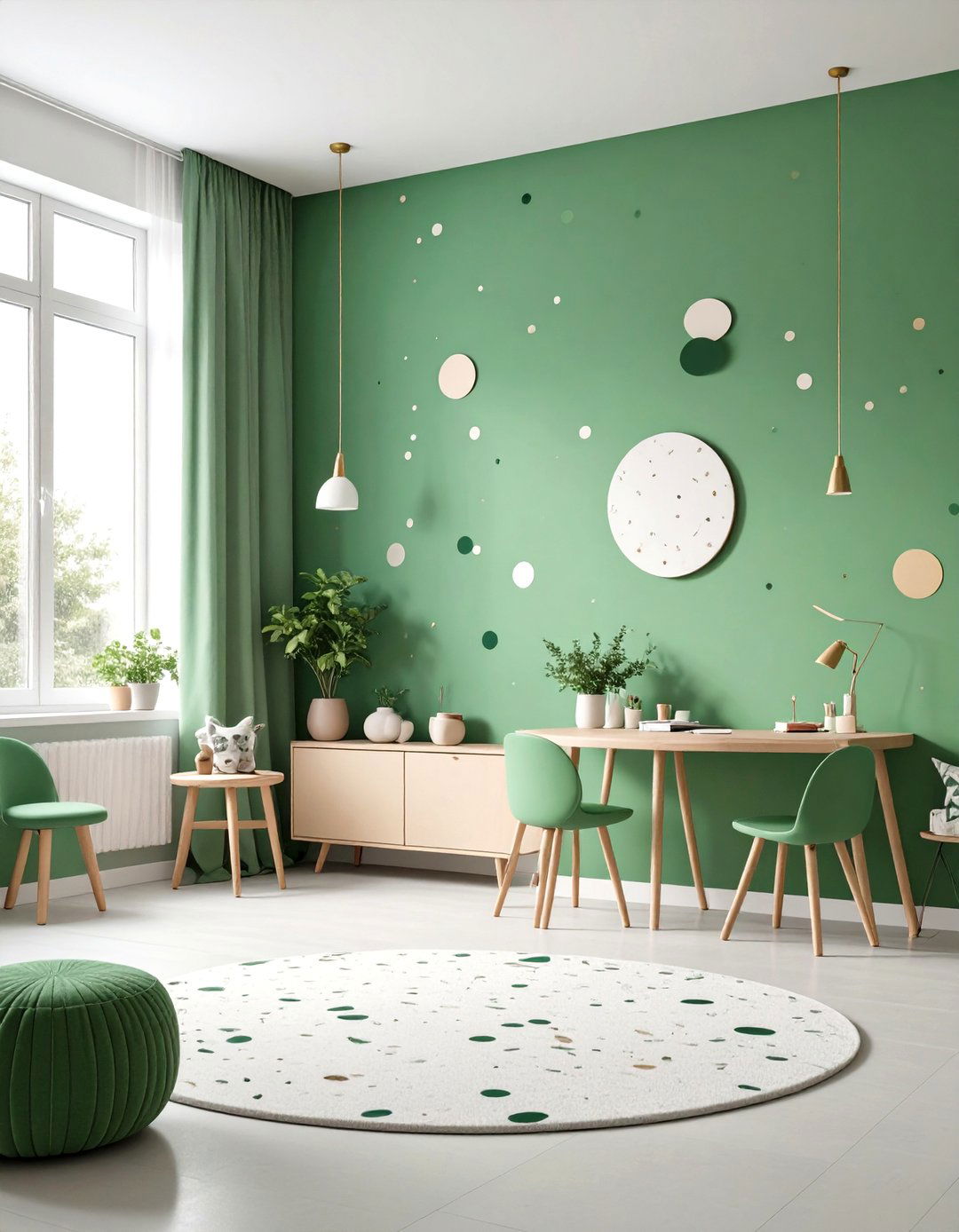
Splattering emerald, pistachio, and cream “chips” across a pale-green base recreates terrazzo’s joyful confetti at a fraction of tile cost. Use stiff bristle brushes and angled flicks to control speck sizes; practising on cardboard first helps. Seal with a clear, matte polyurethane so specks don’t scratch off. The playful pattern suits kids’ baths, laundry rooms, or creative studios where energy matters more than polish. Echo one chip colour in a rug to unify the look, and keep cabinetry simple so the lively wall doesn’t fight for attention.
17. Mid-Century Avocado Green Accent Wall for Retro Warmth
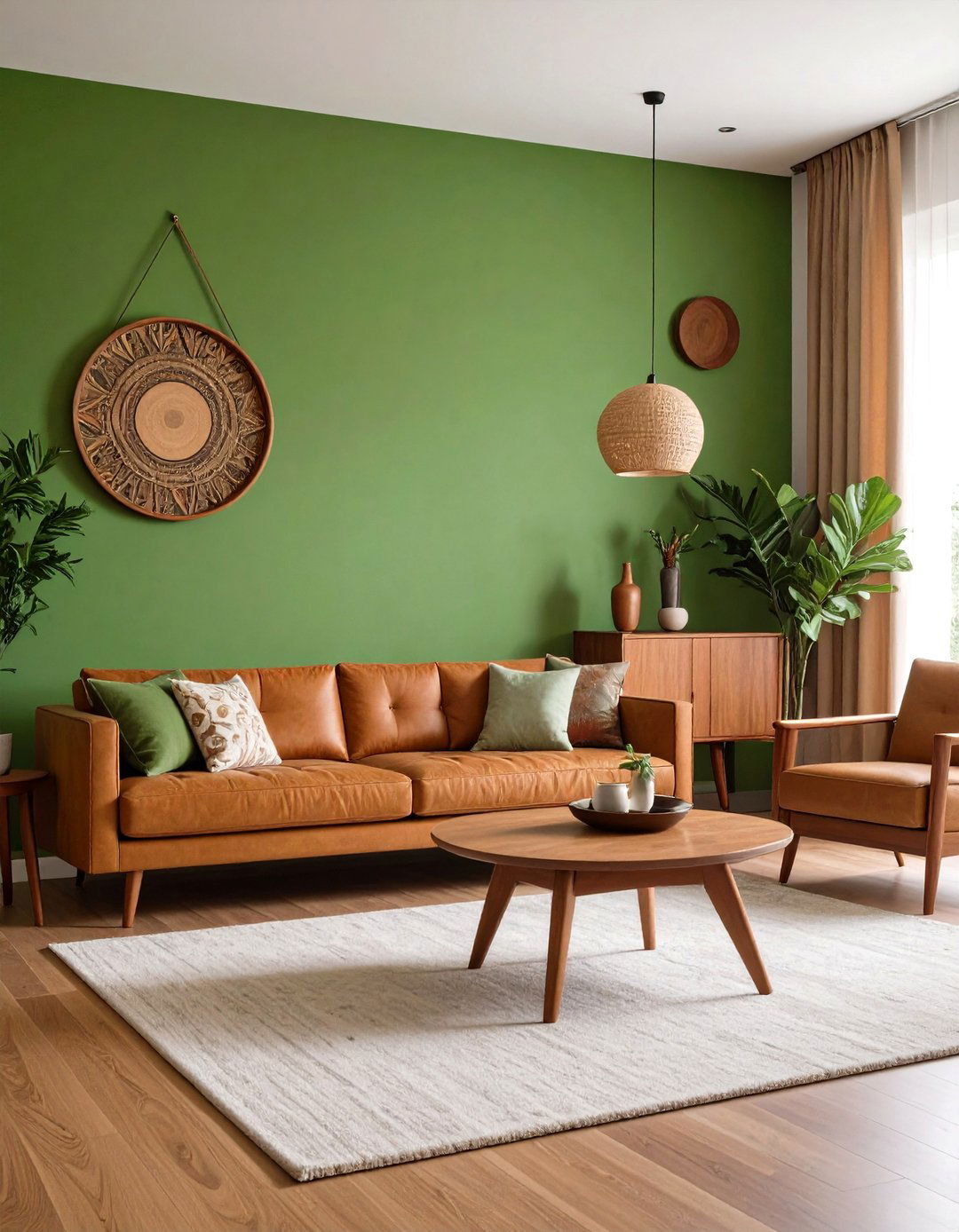
Avocado green, once a 1970s appliance staple, is back in smaller doses as a nostalgic accent wall that pairs beautifully with teak sideboards and geometric art. Choose a satin finish to mimic vintage enamel without going full gloss. To modernise, mix in crisp whites and a single brass floor lamp for contemporary shine. If the hue feels heavy, paint the wall’s upper 30 percent a lighter off-white to create airy proportion while keeping retro roots. Complete the vibe with a shag runner in neutral oat to soften sharp furniture angles.
18. Metallic Gold-Stenciled Green Accent Wall for Glam

Layering metallic-gold stencil over a dark green base instantly elevates a bedroom or powder room into boutique-hotel territory. Opt for large Moroccan or Art Deco motifs to avoid dizzying repeats. Use repositionable spray adhesive on the stencil and stipple metallic paint lightly; overloading bleeds edges. Finish with a water-based poly to guard against tarnish, especially in humid rooms. Balance the luxe wall with simple linens and matte-black hardware so it steals the spotlight. Small space? Stencil only the centre panel and frame with slim moulding for a glam but manageable statement.
19. Hallway Soft Green Accent Wall to Visually Expand Space
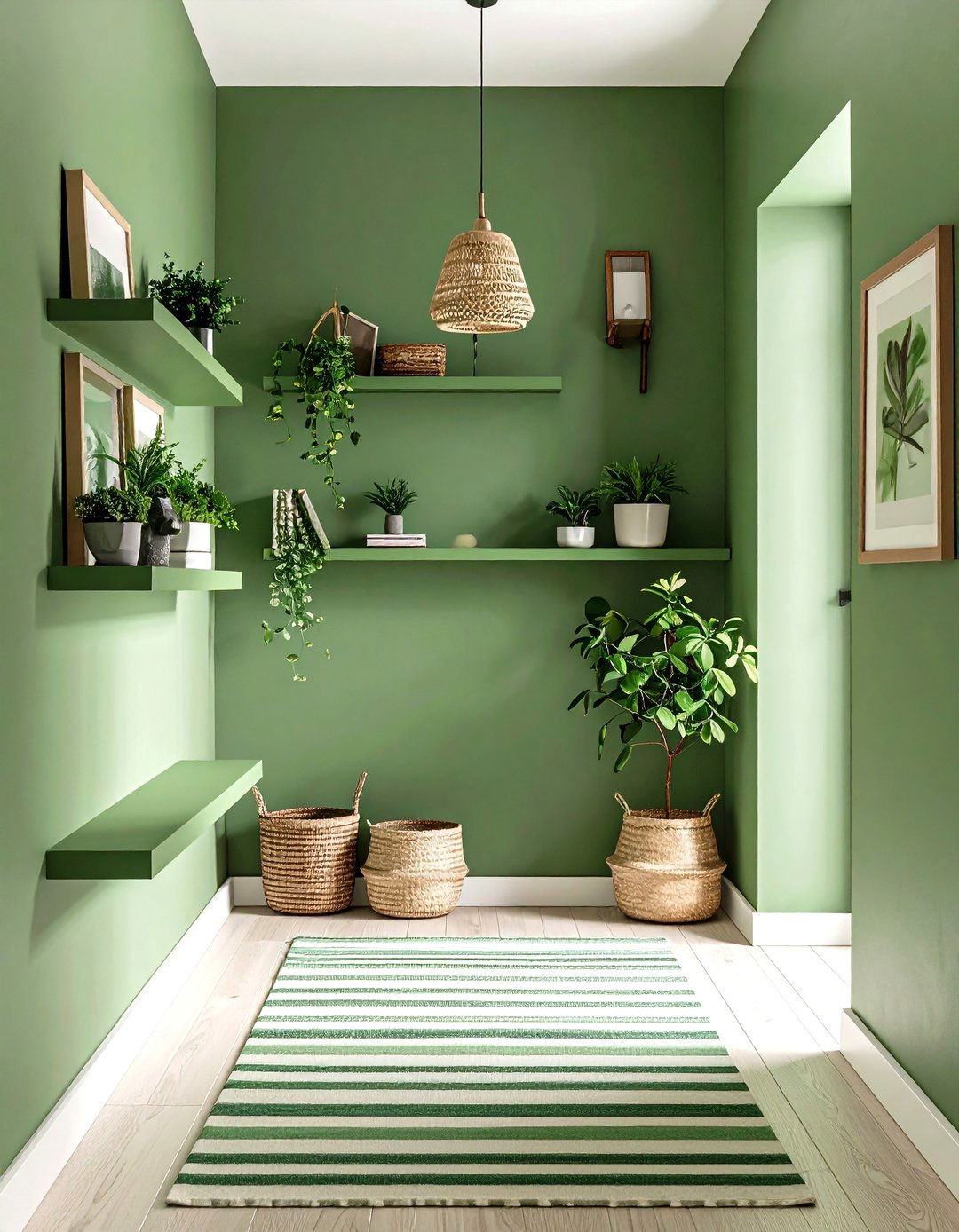
Painting the longest hallway wall a gentle sage draws sightlines forward and makes tight passages feel brighter and wider—a trick colour pros swear by for busy thoroughfares. Choose a light-reflective eggshell so overhead pendants bounce off the surface, reducing tunnel effects. Keep the opposite wall neutral to maintain balance, and install slim picture ledges in matching green for rotating art without nail clutter. Finish with a striped runner to emphasise length, visually stretching the corridor while the cool hue calms household traffic.
20. Emerald Green Accent Wall with Gallery Picture Ledge

Installing a slim picture ledge across an emerald wall turns framed art into an ever-changing exhibit—perfect for indecisive curators. A saturated backdrop unifies mismatched frames, while the ledge eliminates multiple nail holes. Mount the shelf 56 inches from the floor (standard eye level), then style art in odd numbers for rhythm. Paint the ledge the same green to keep frames floating; a contrasting wood shelf makes it a statement beam. Add a slim wall sconce at one end to spotlight favourite prints and invite nightly refreshes without a hammer.
Conclusion:
Green accent walls satisfy the current craving for colour that nurtures well-being while showcasing personal style through texture, pattern, and clever finish choices. Whether you lean toward sage serenity, dramatic forest hues, or playful terrazzo speckles, these approaches prove a single verdant wall can anchor a room, improve acoustics, and echo nature’s calm in spaces large or small. As design trends continue to celebrate character-rich surfaces and restorative palettes, a thoughtfully executed green accent wall remains an easy, high-impact upgrade that grows with your home’s evolving story.


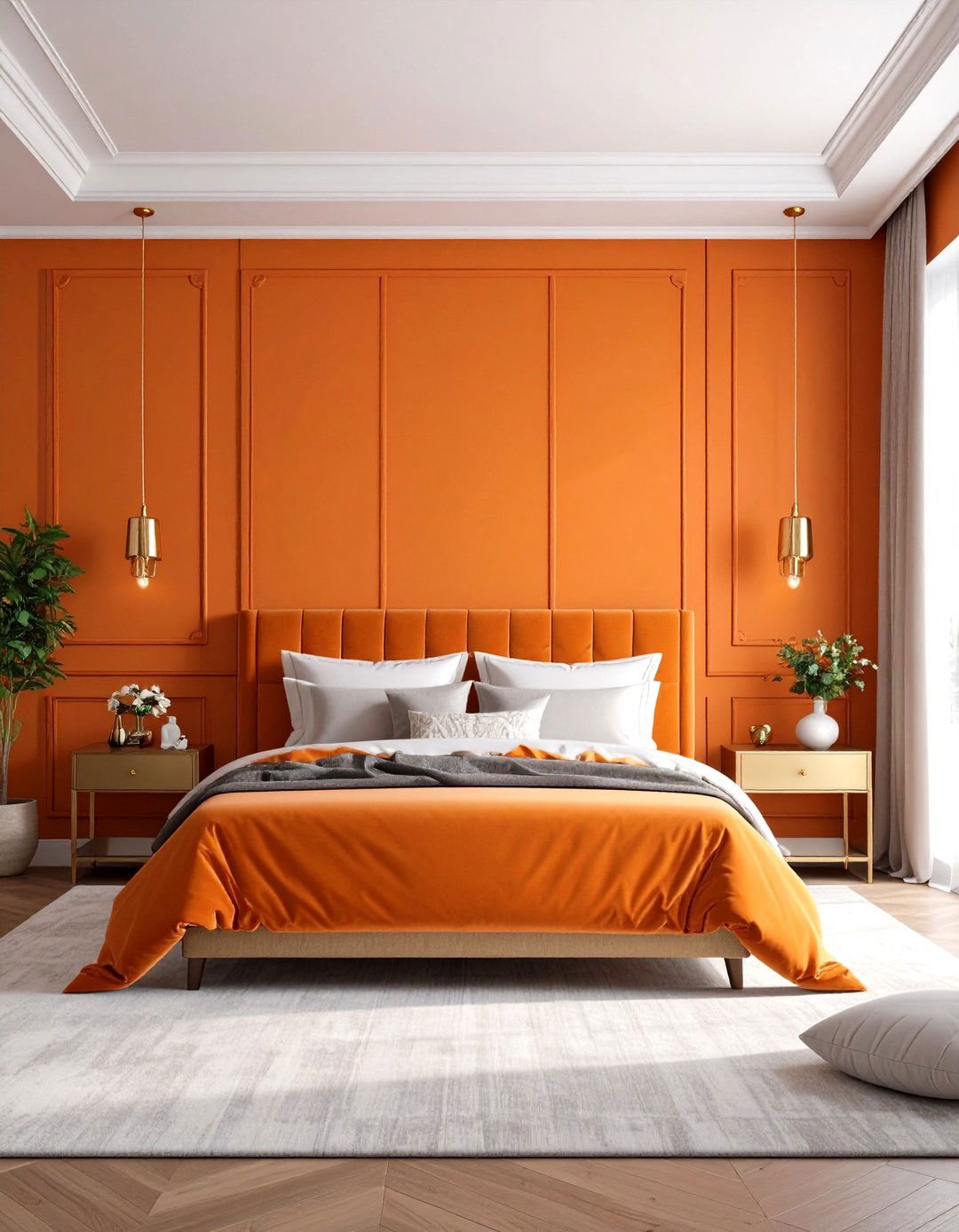
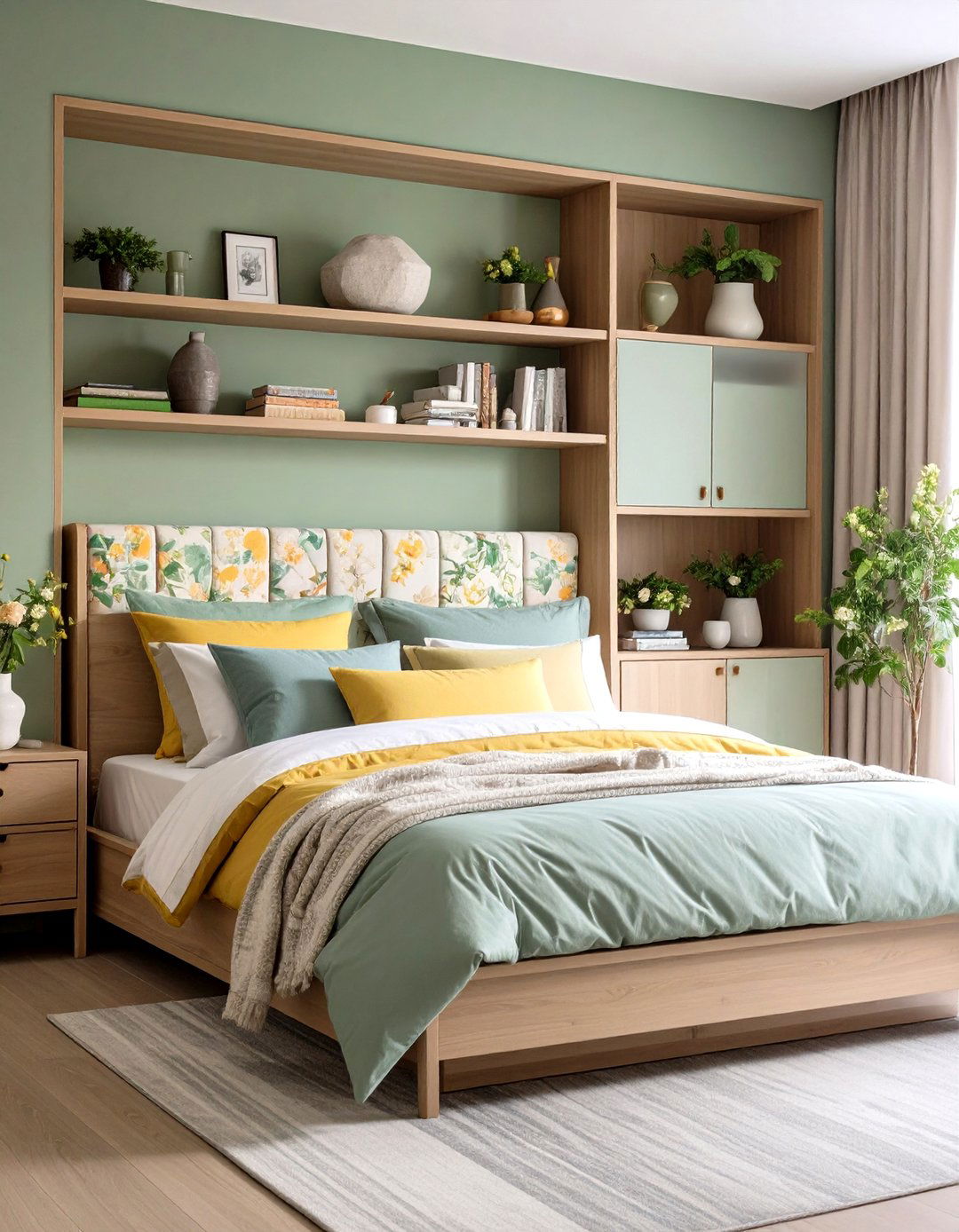
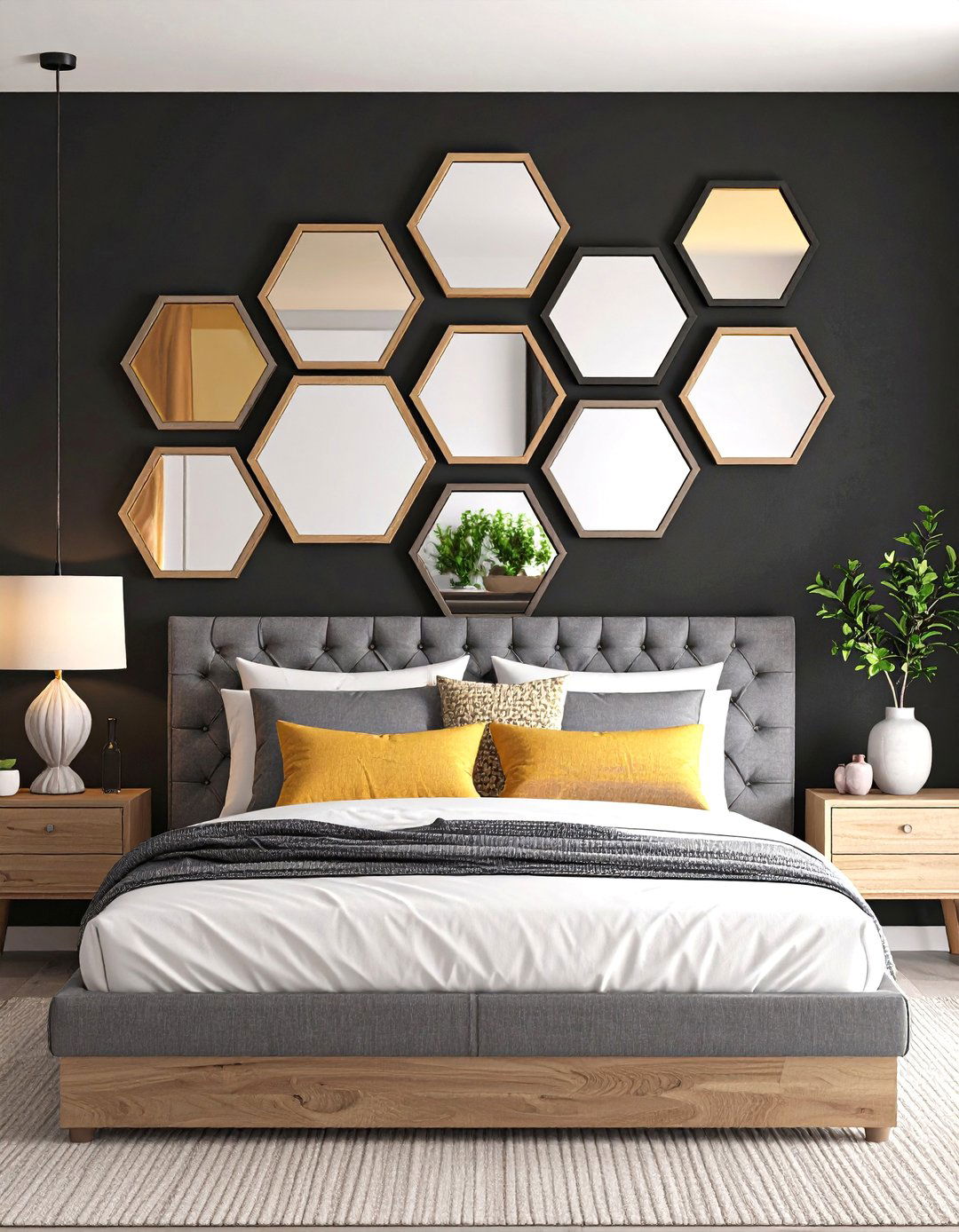

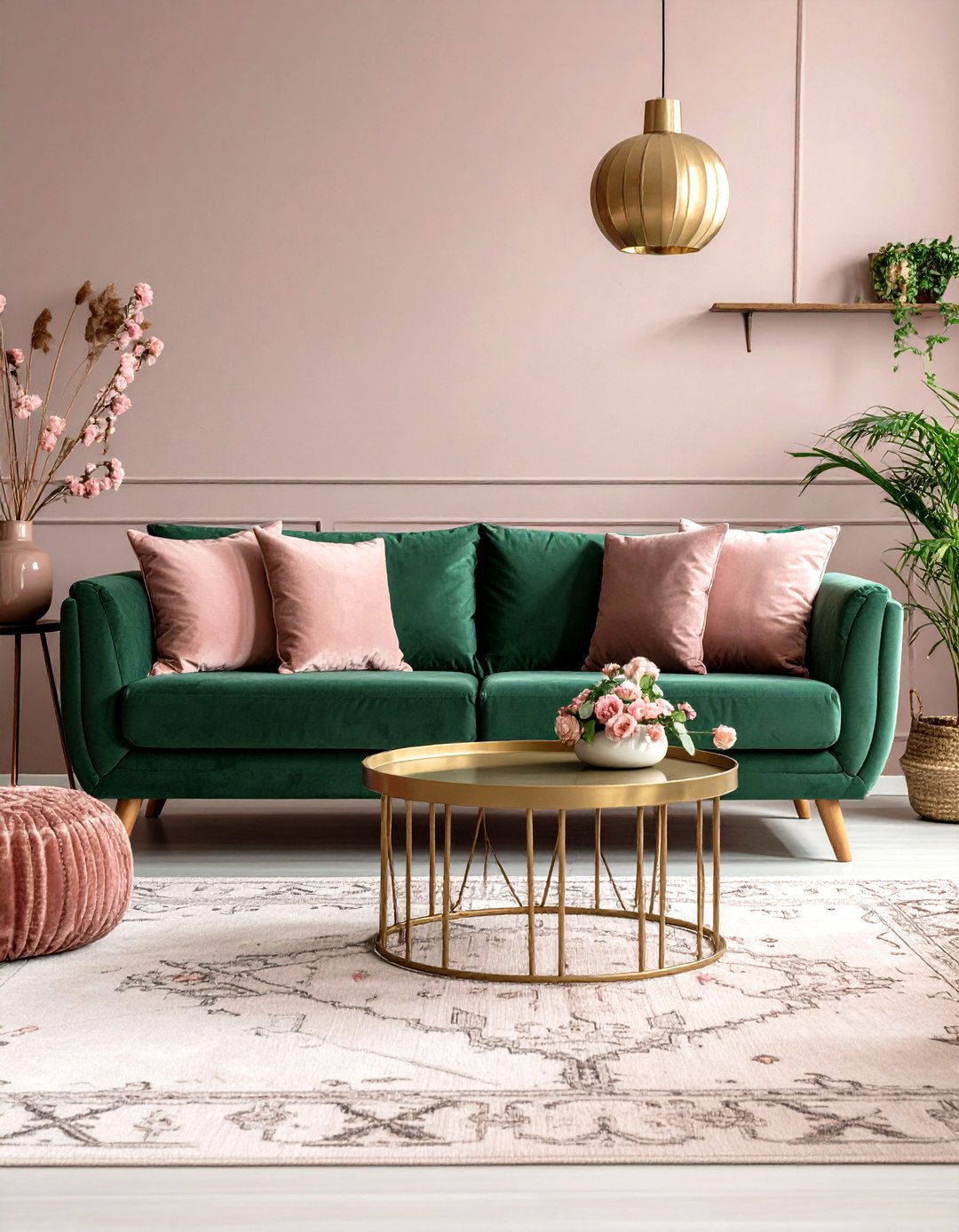
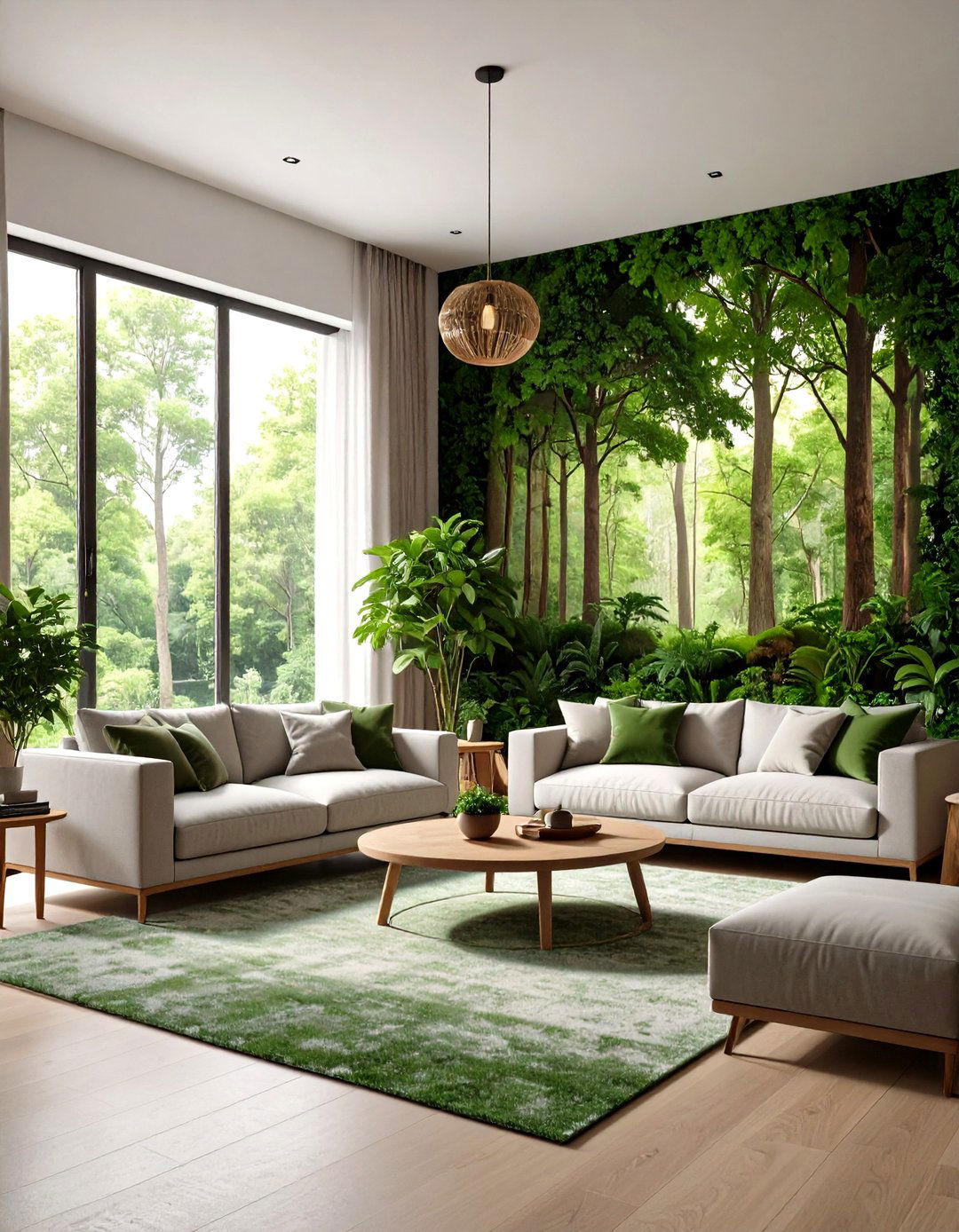

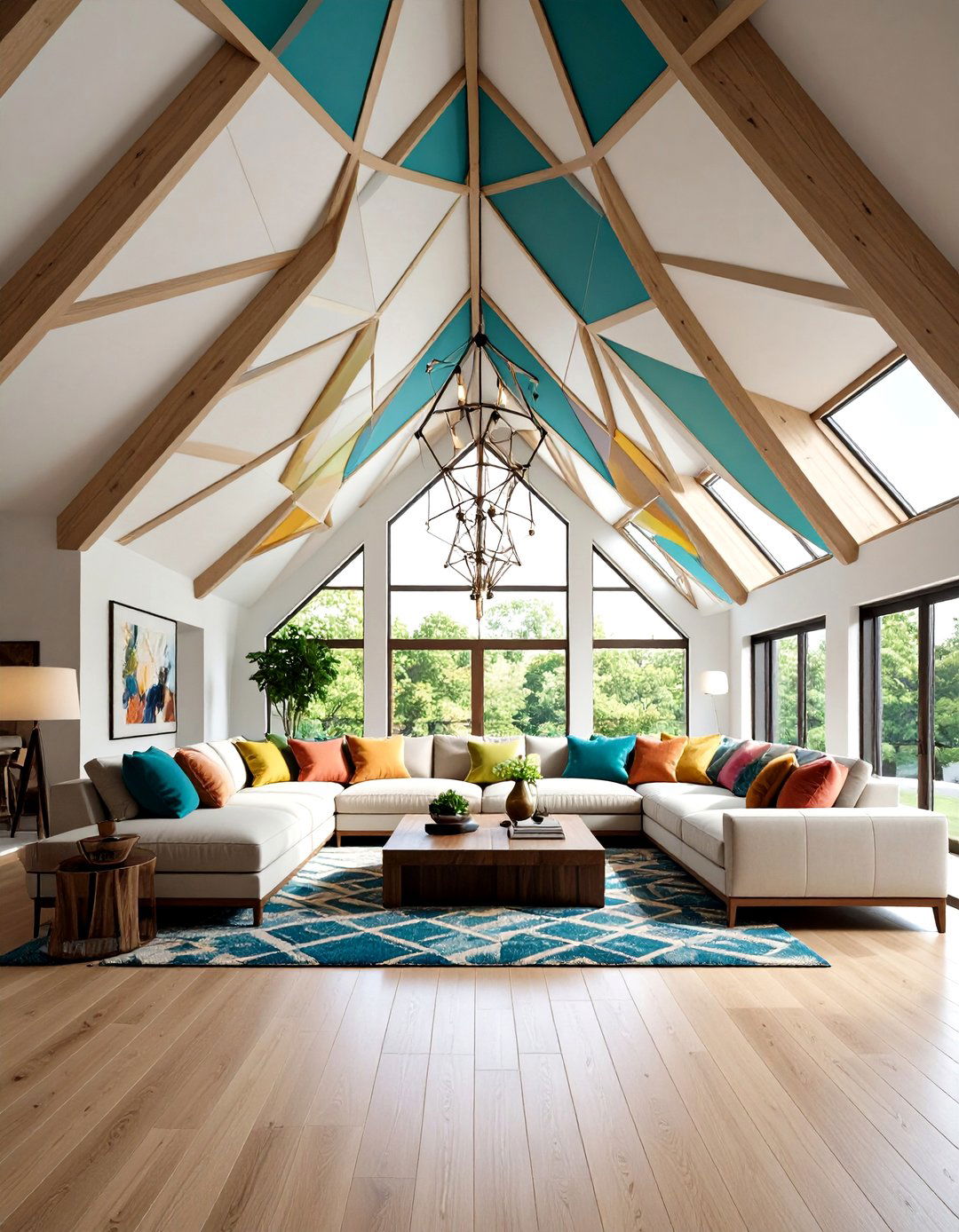
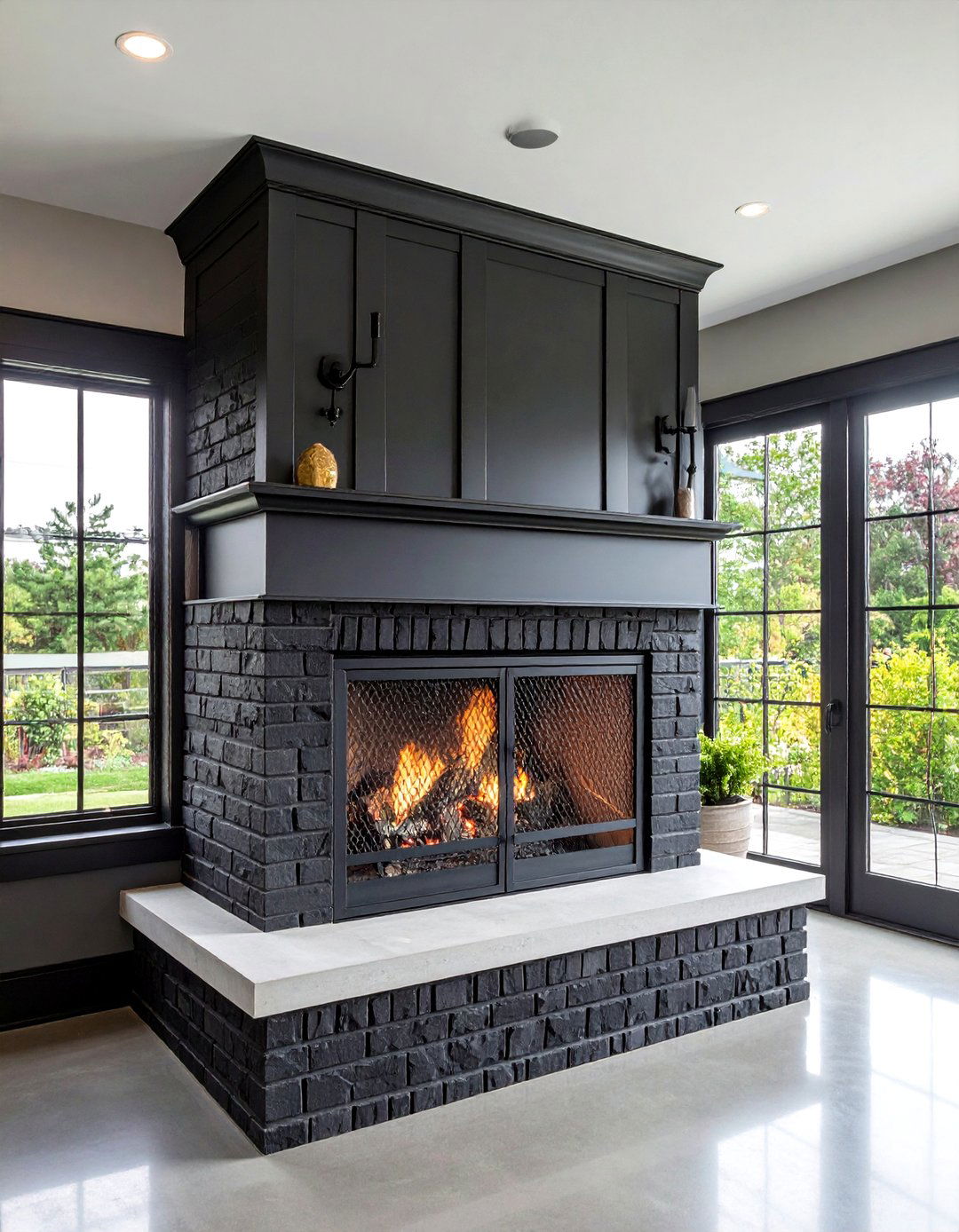
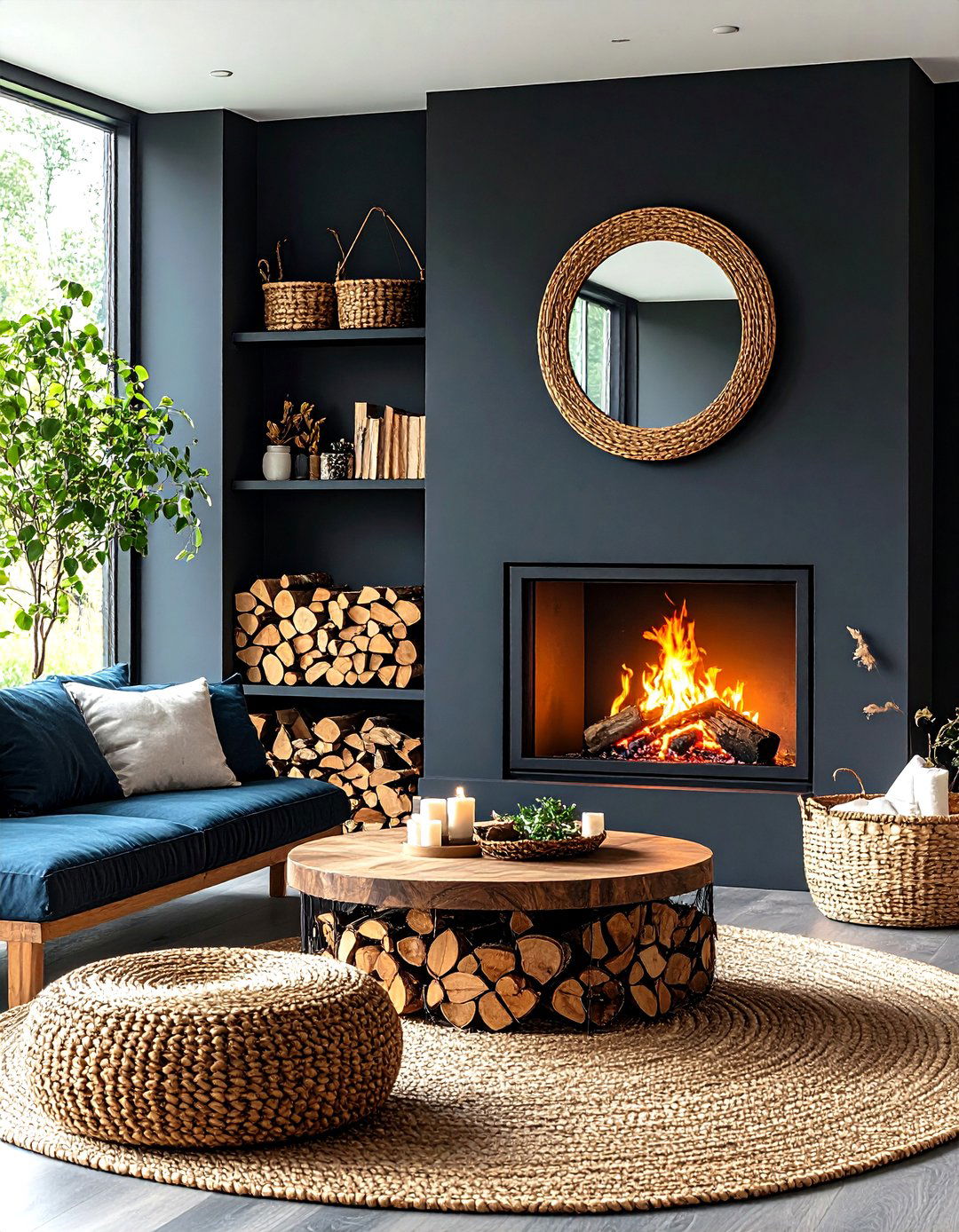
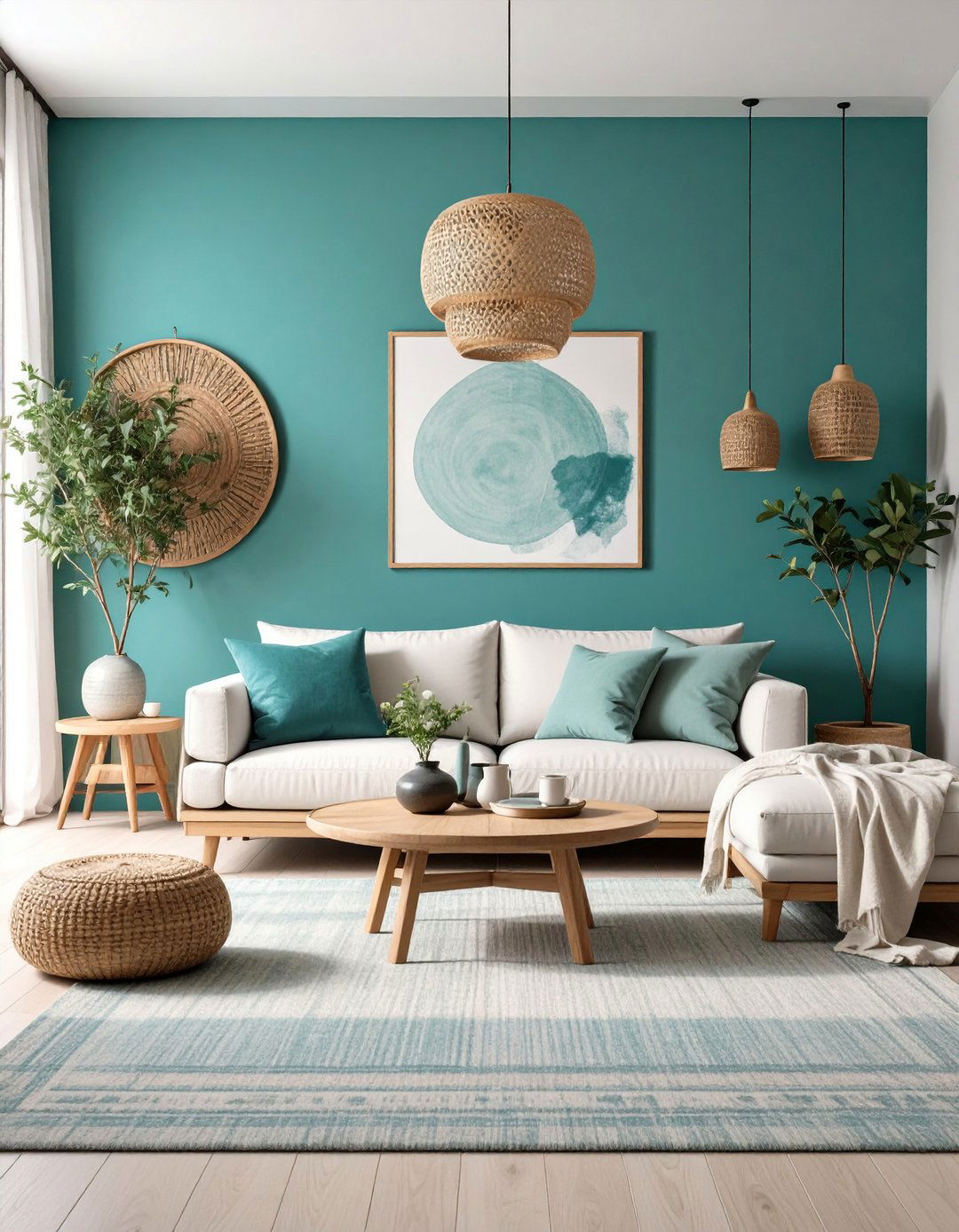
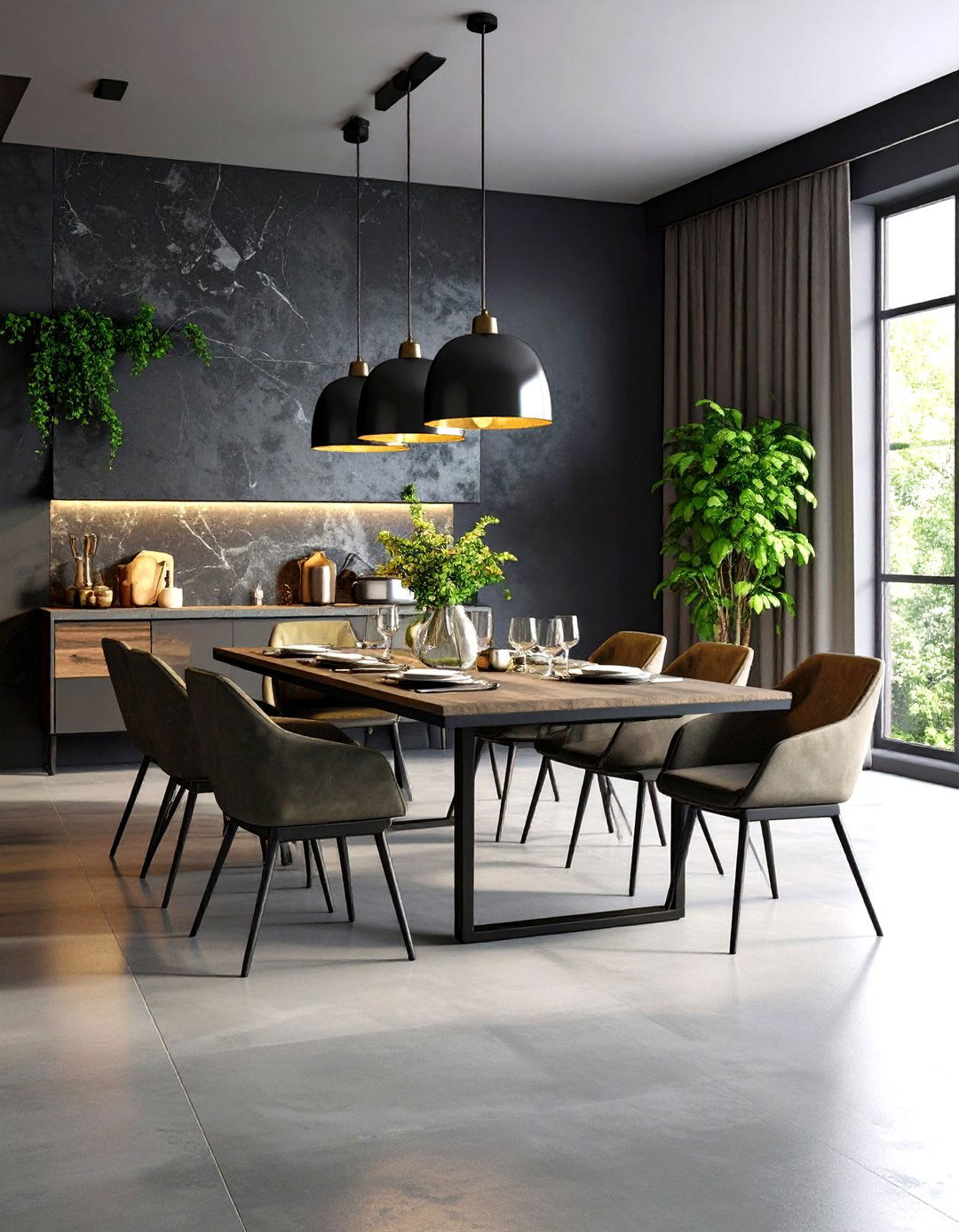
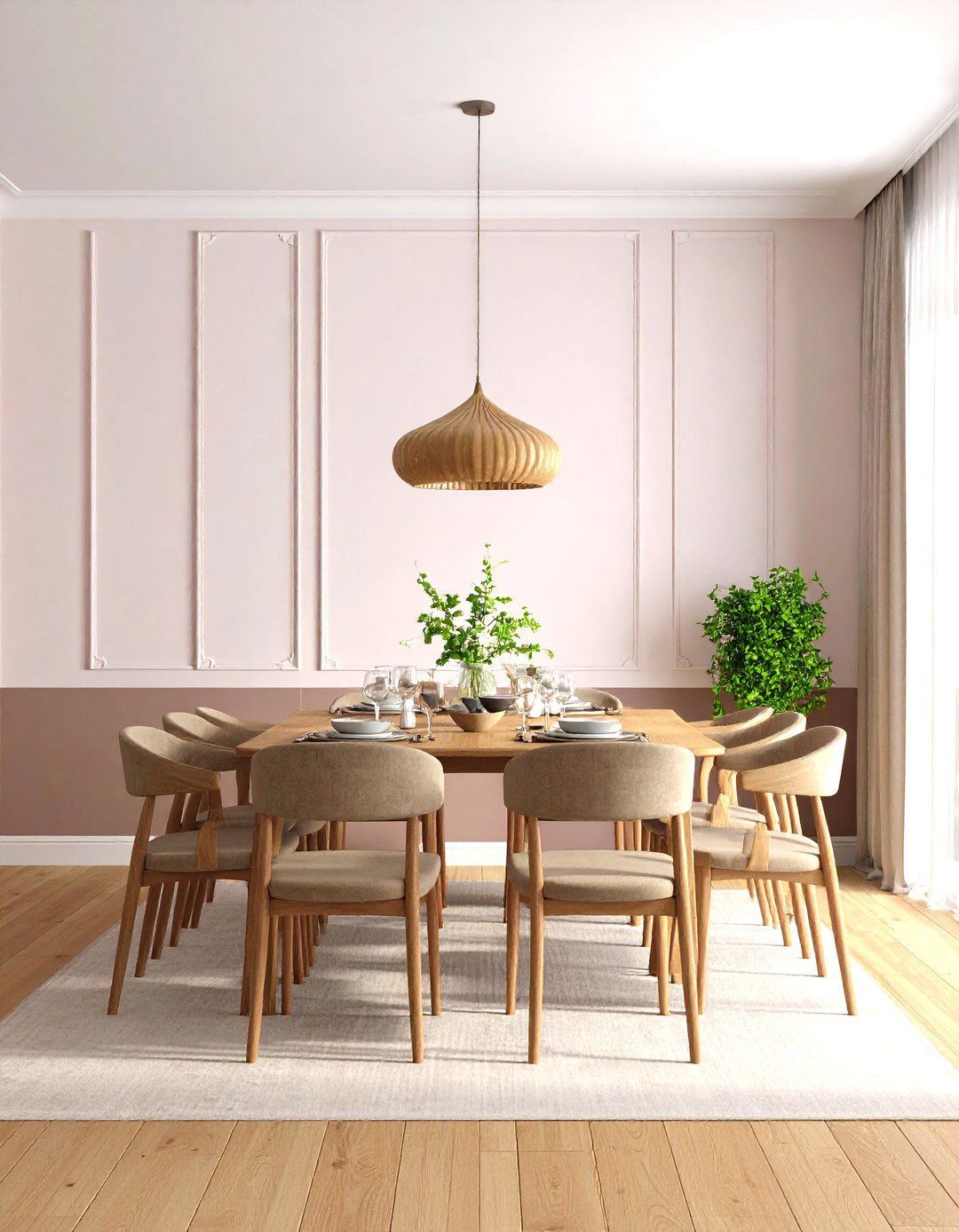
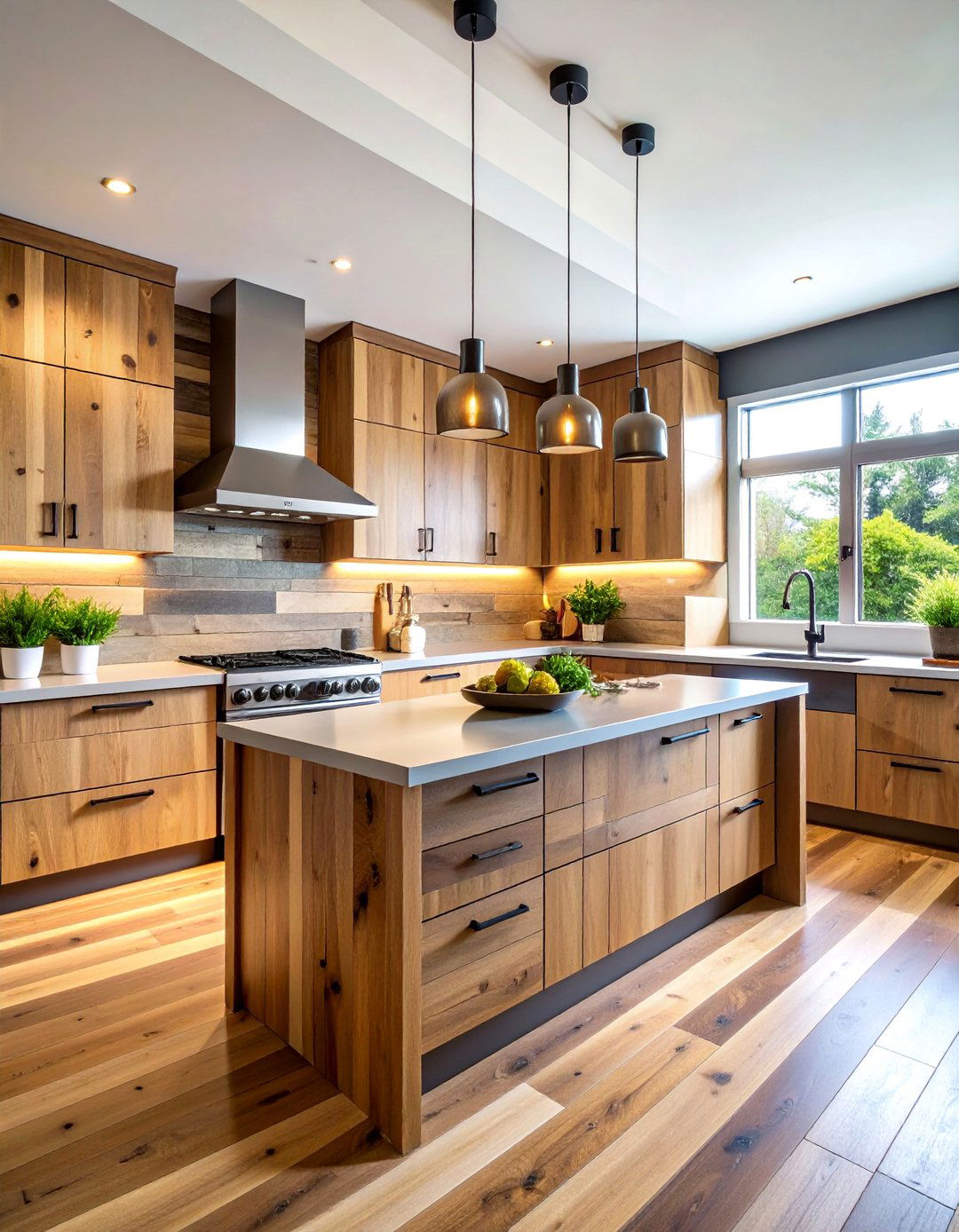

Leave a Reply